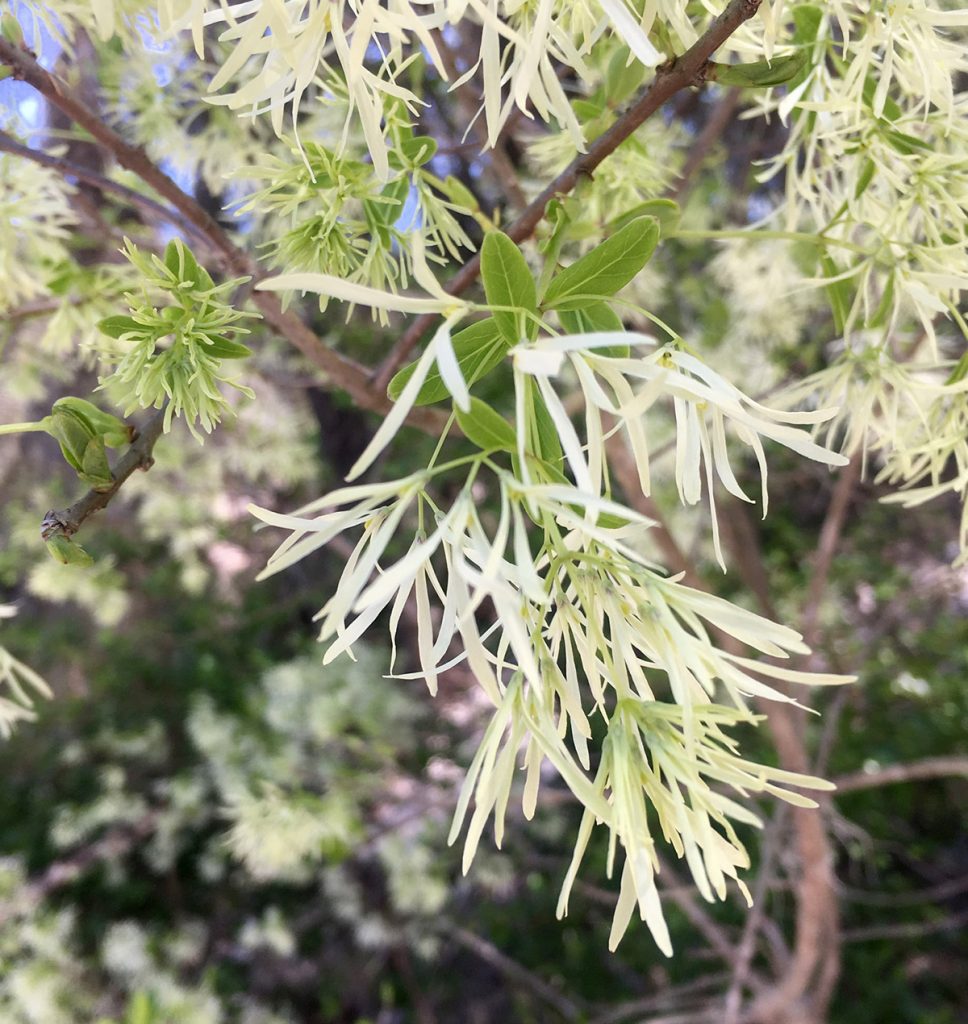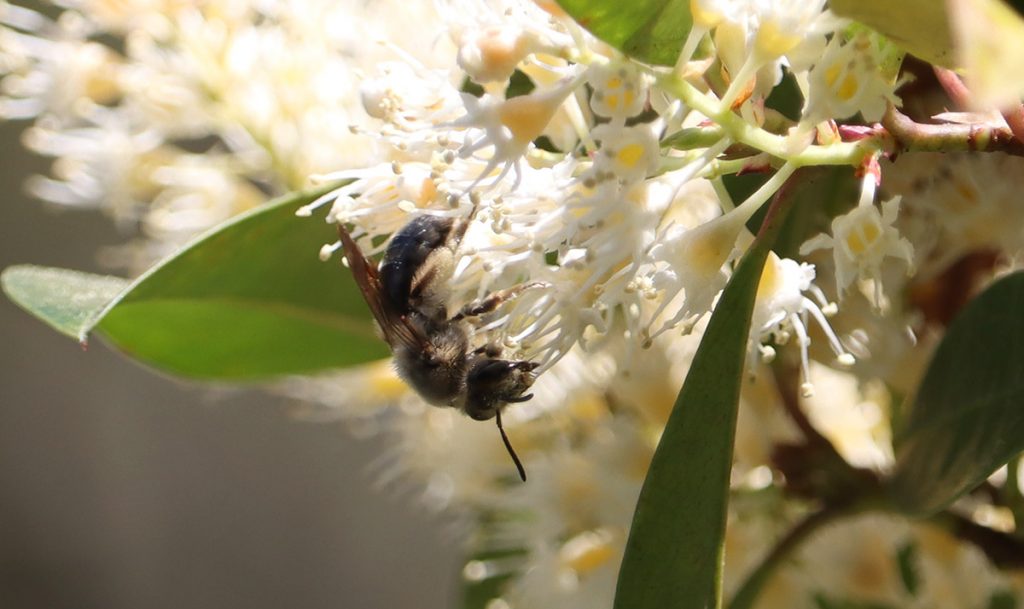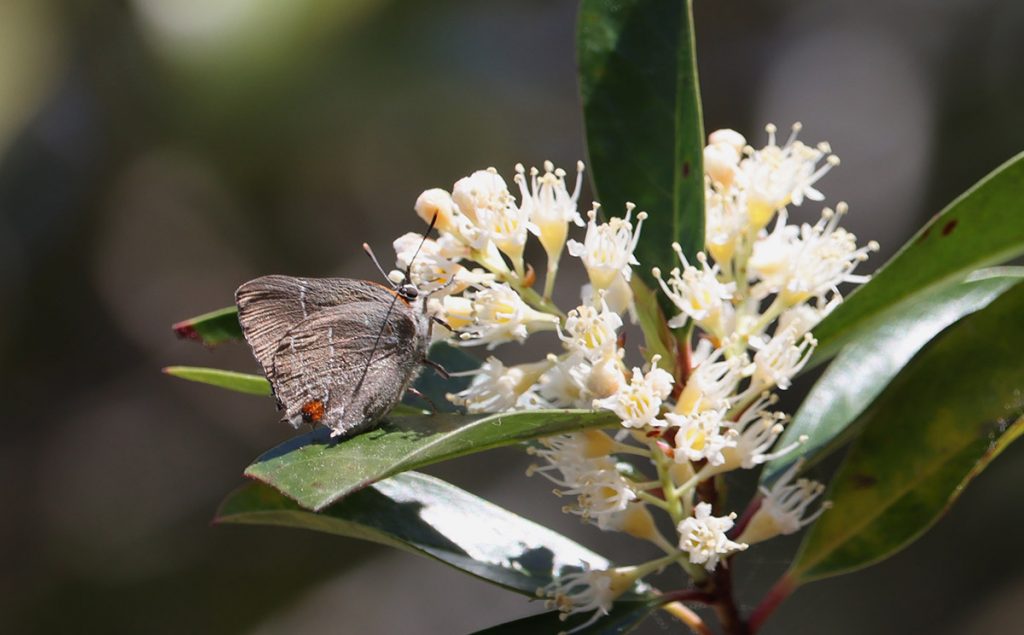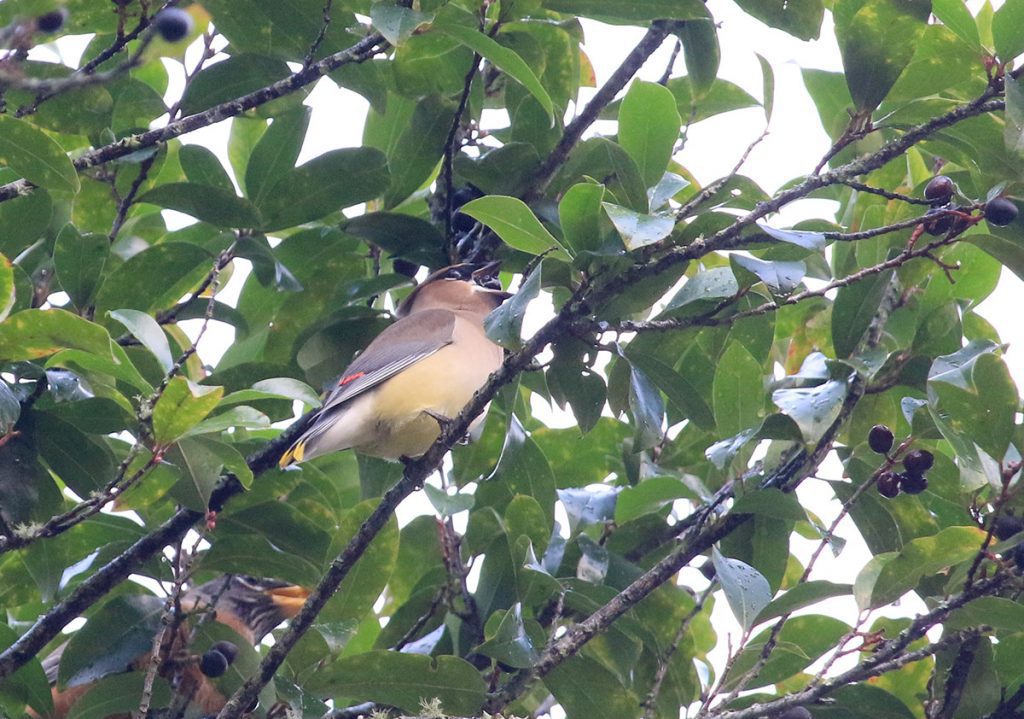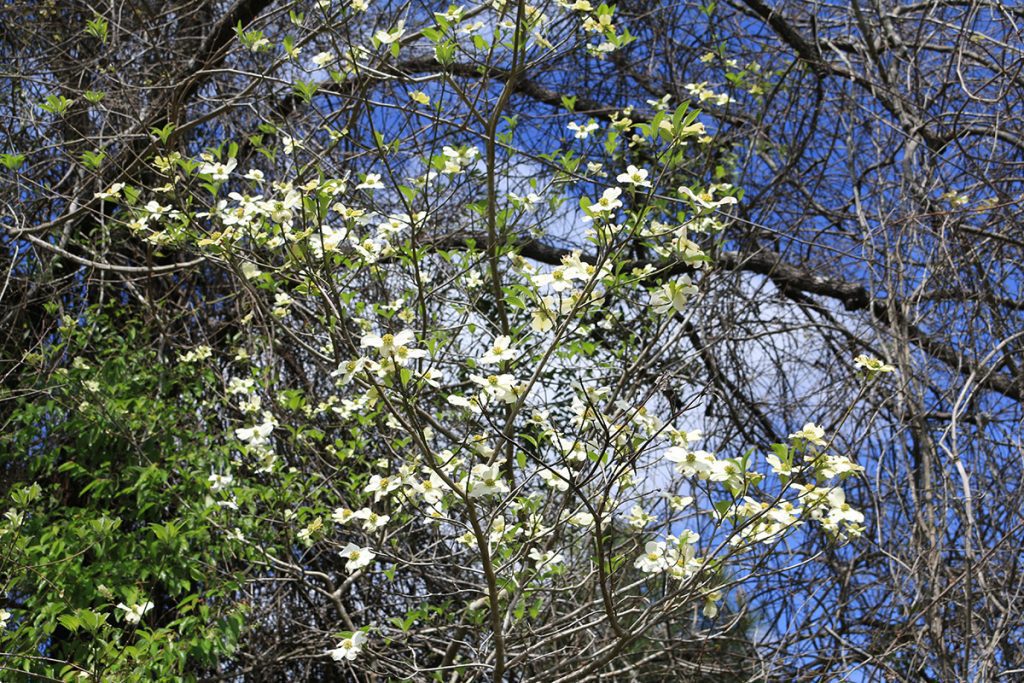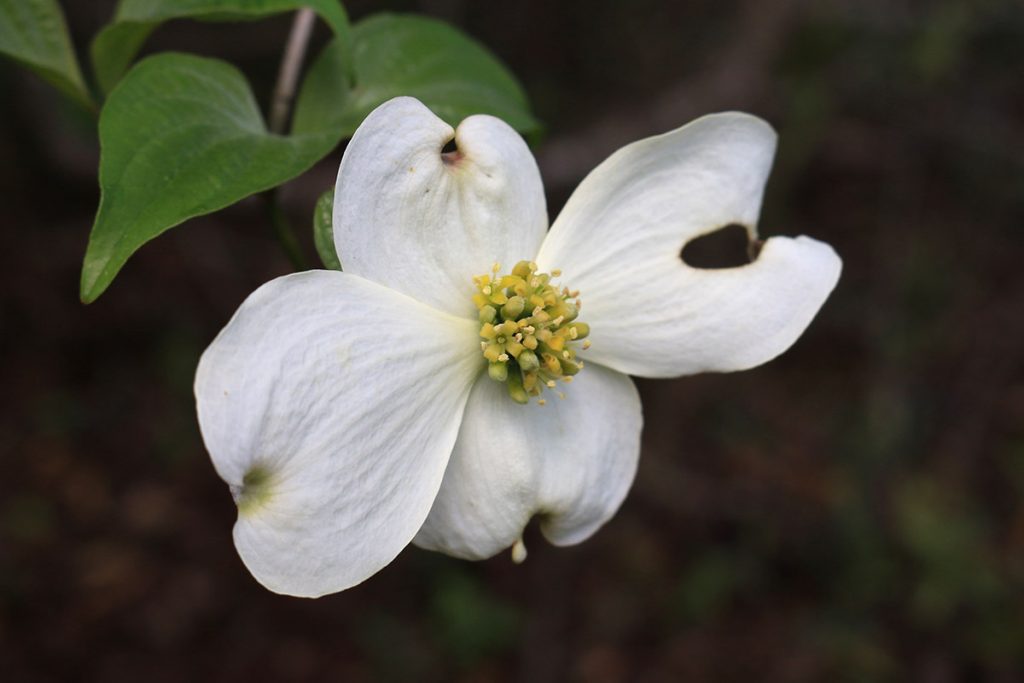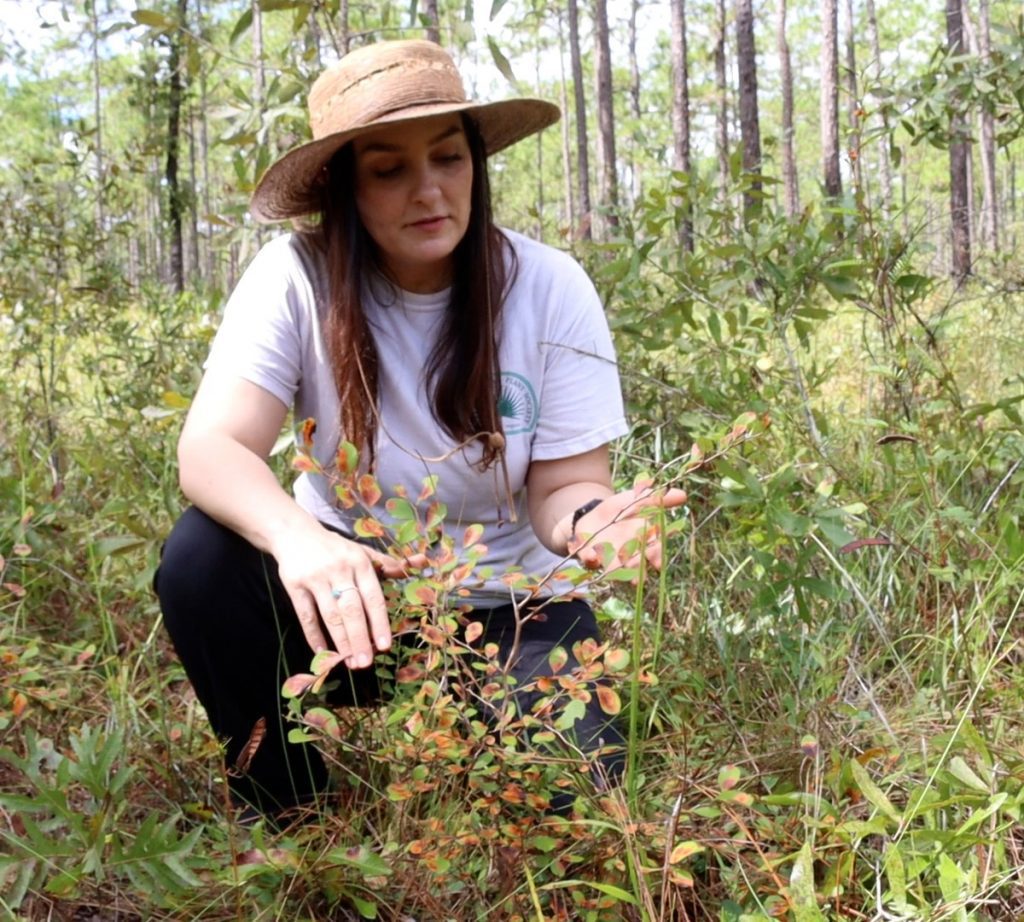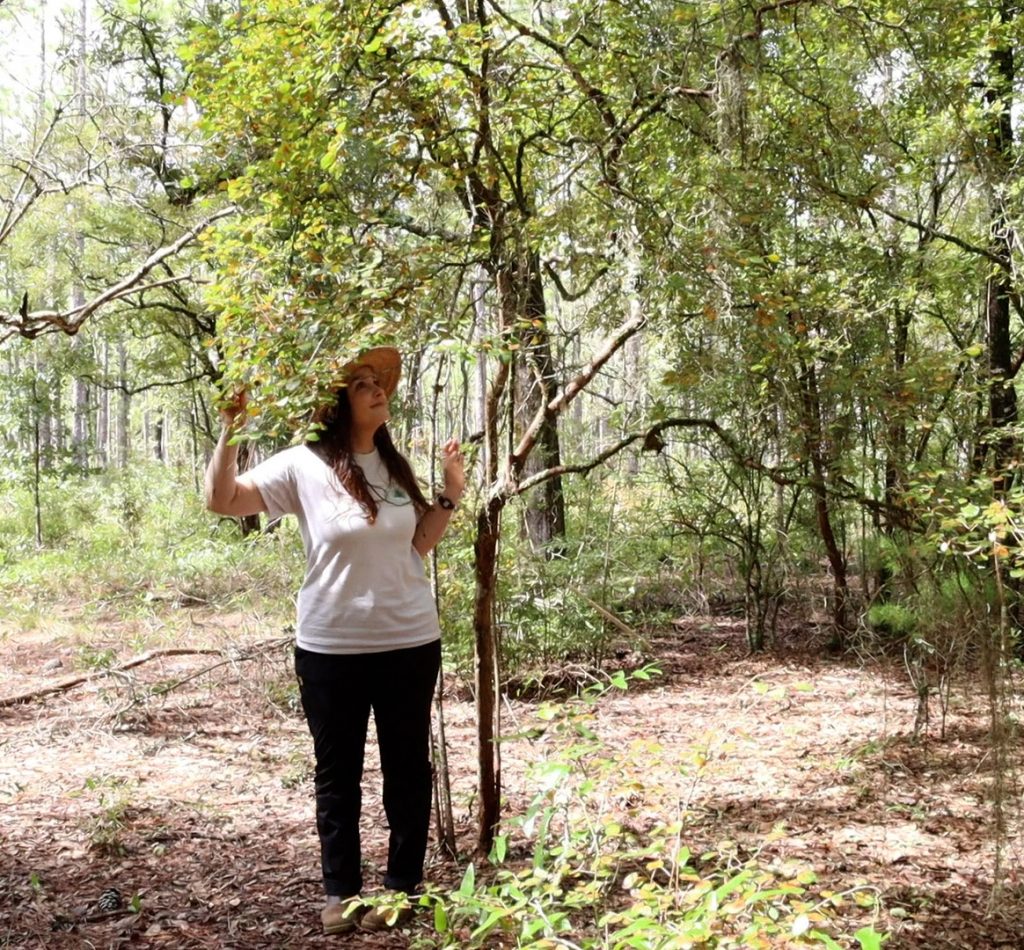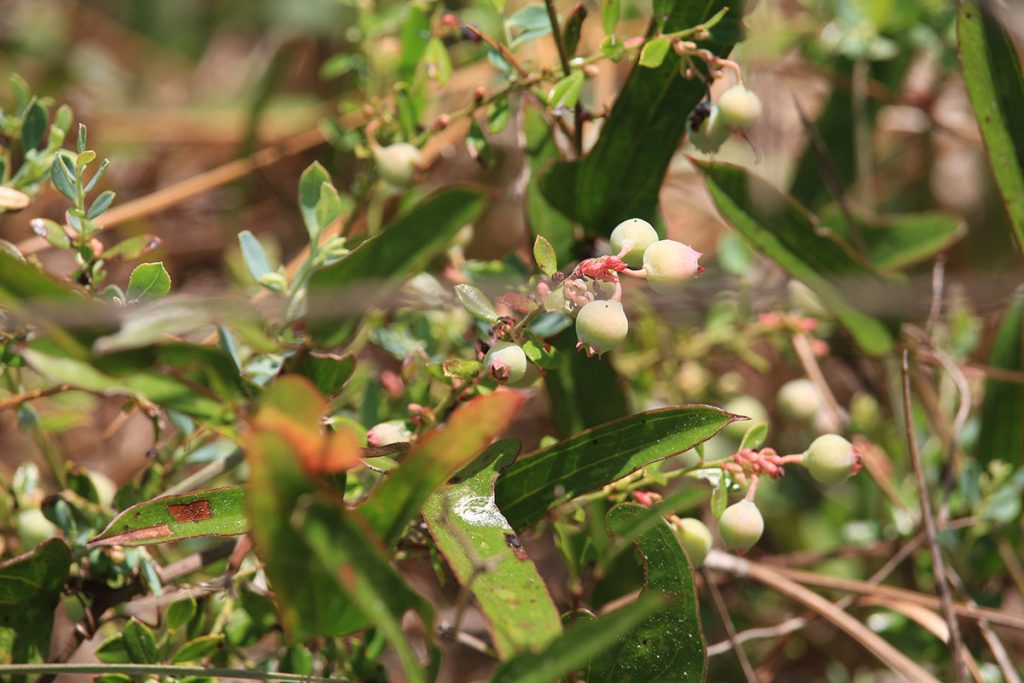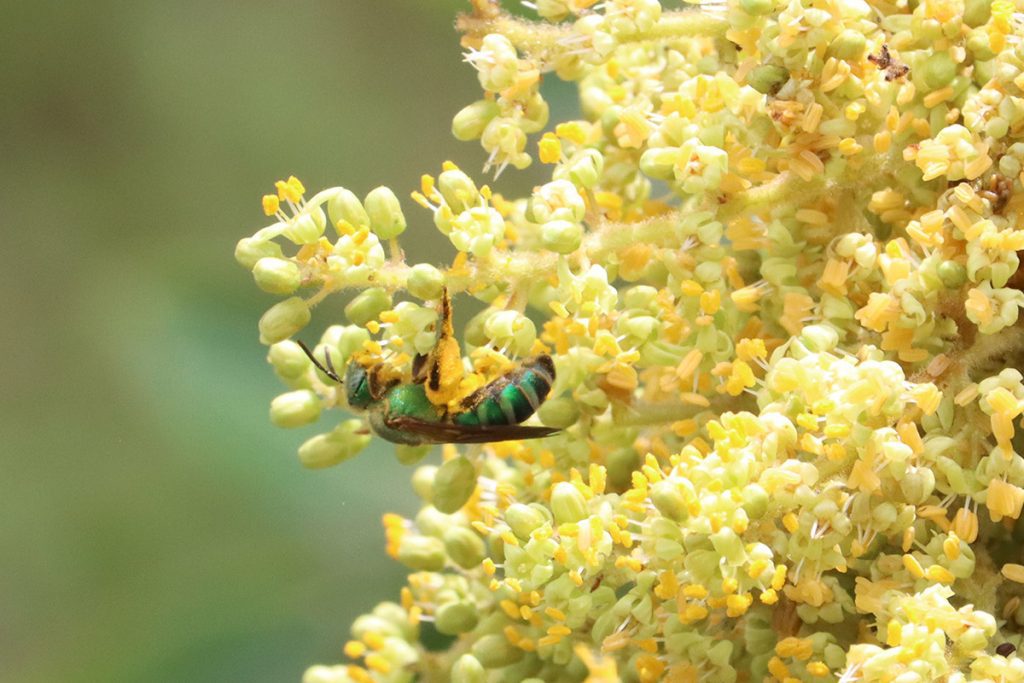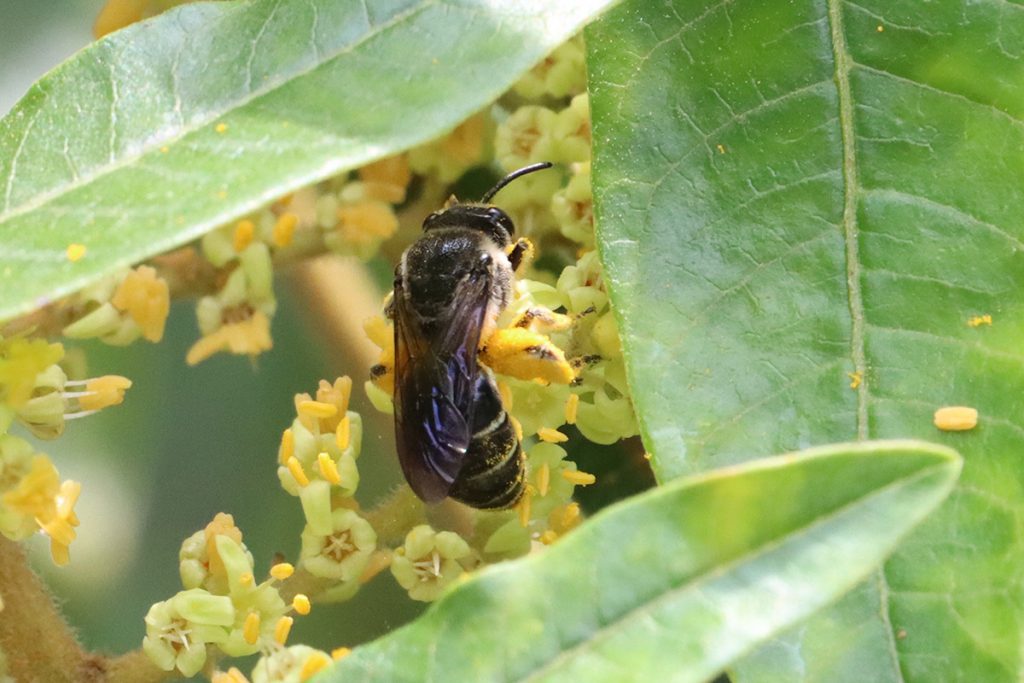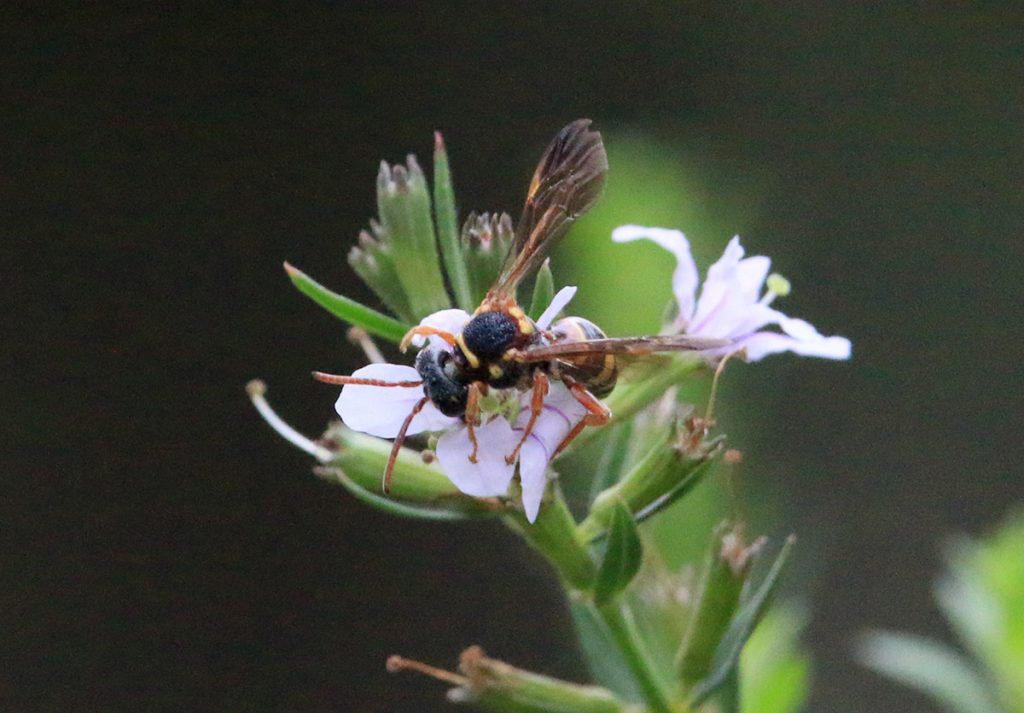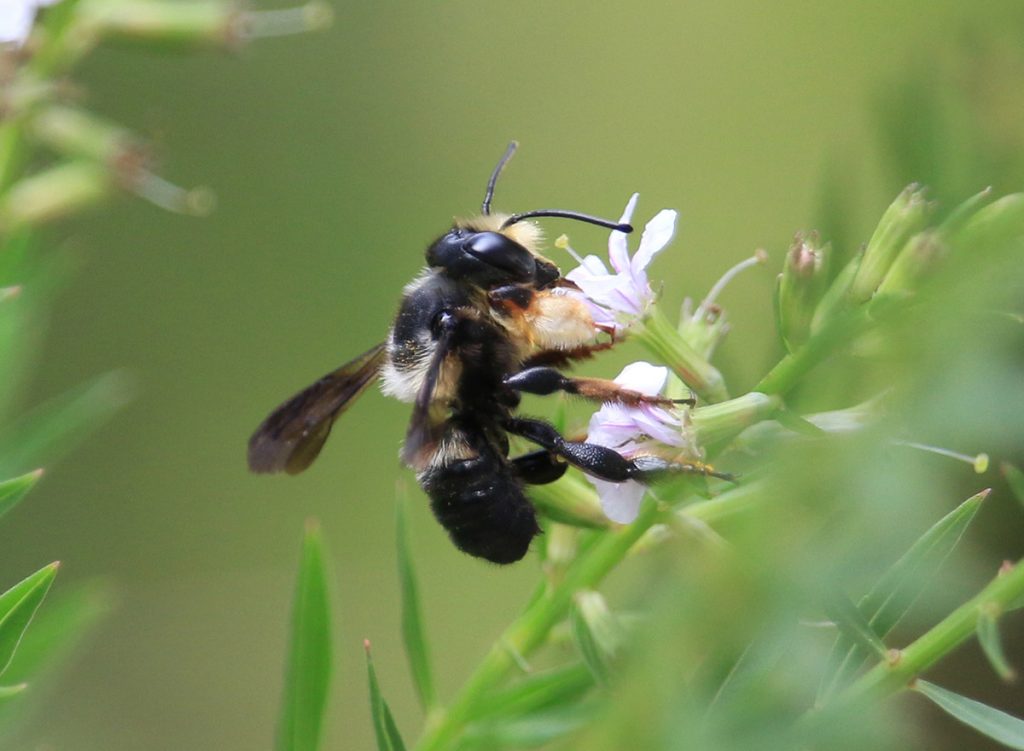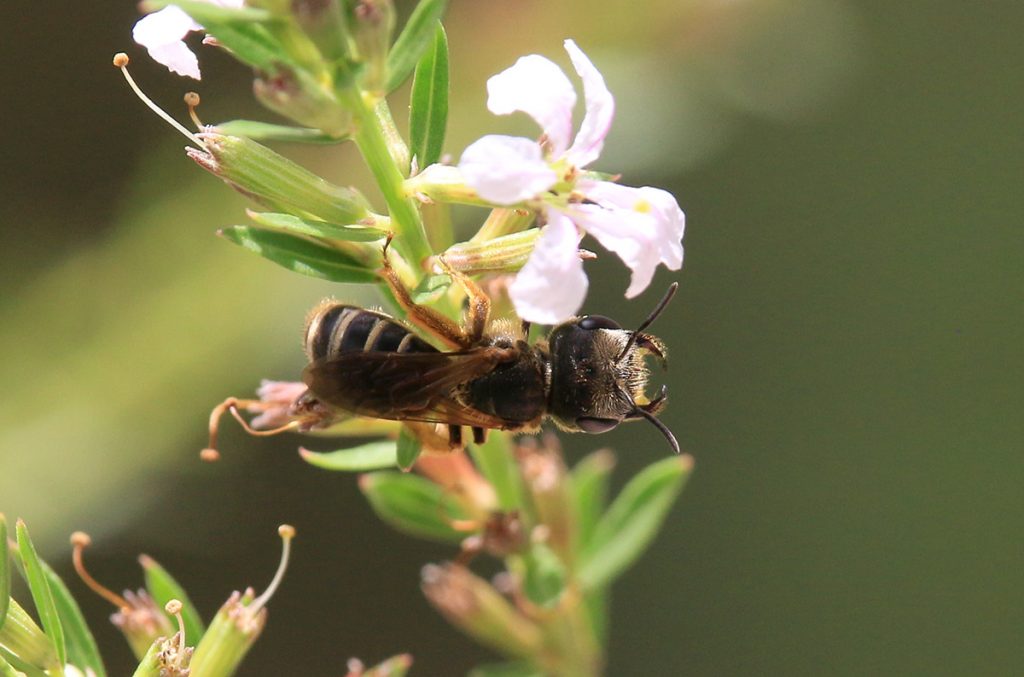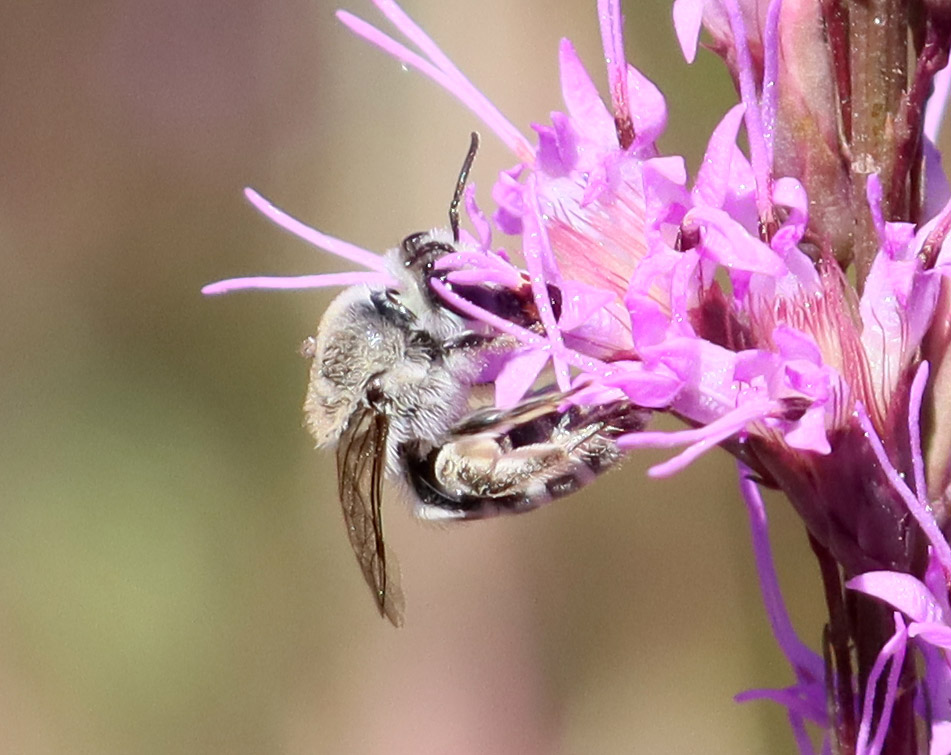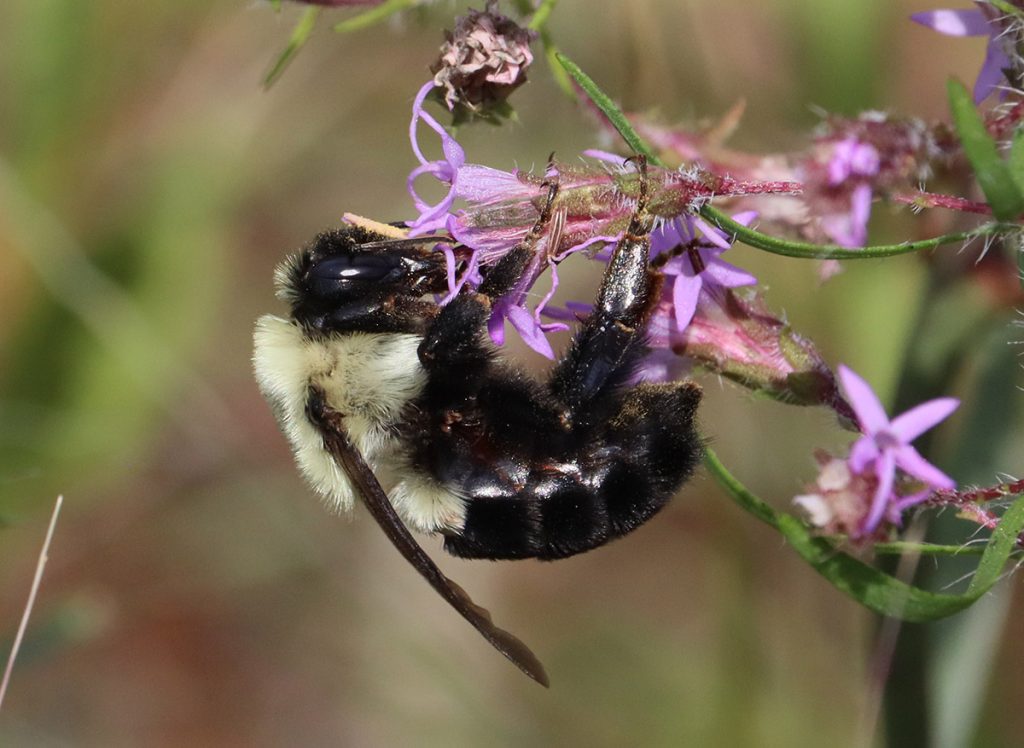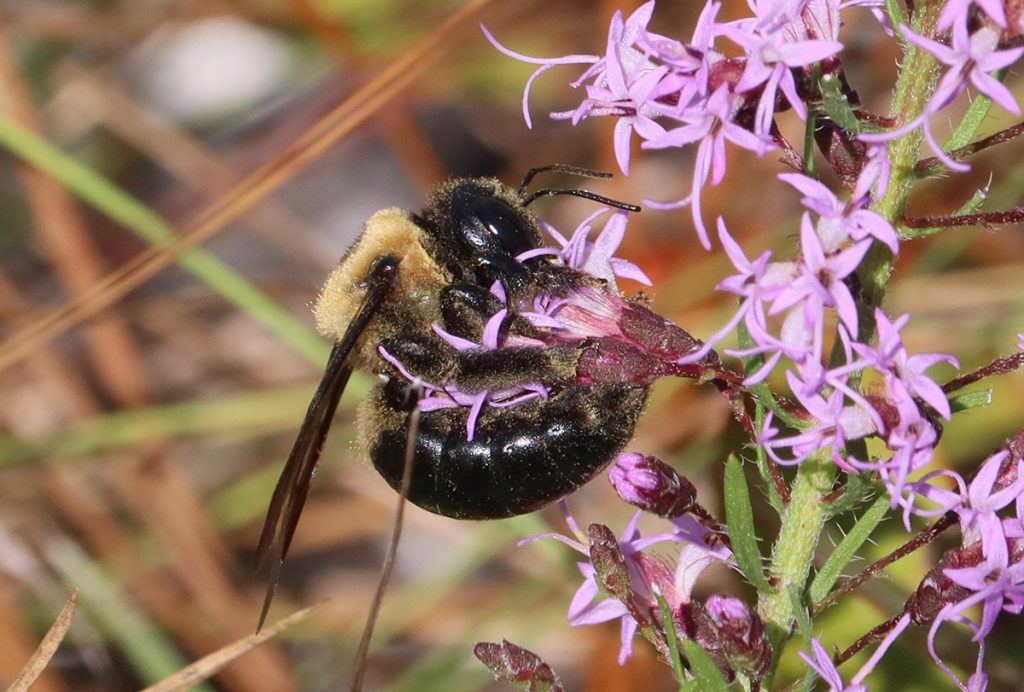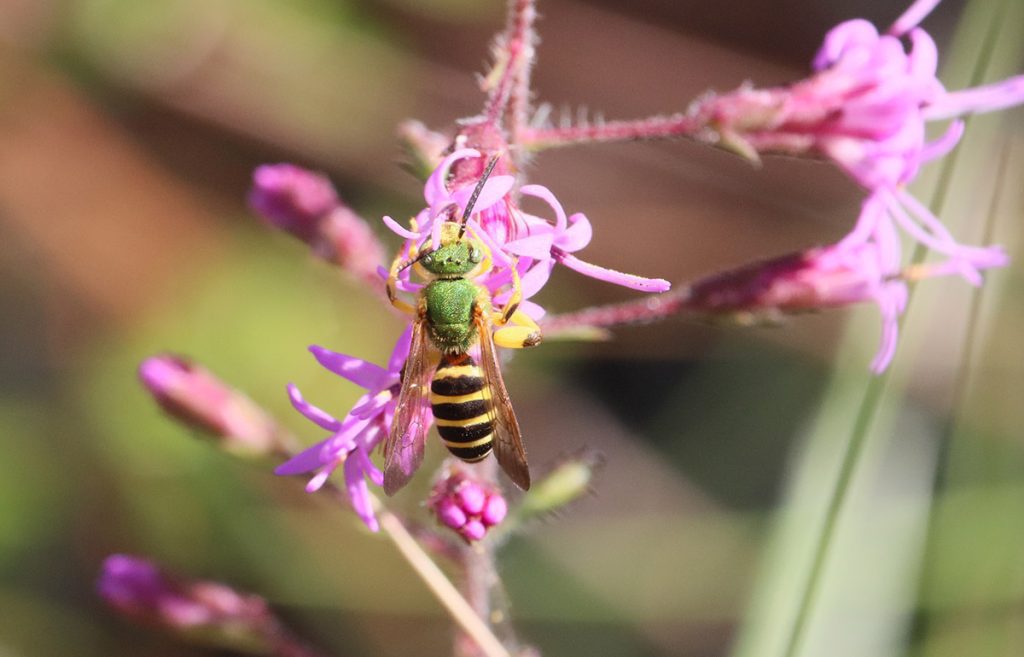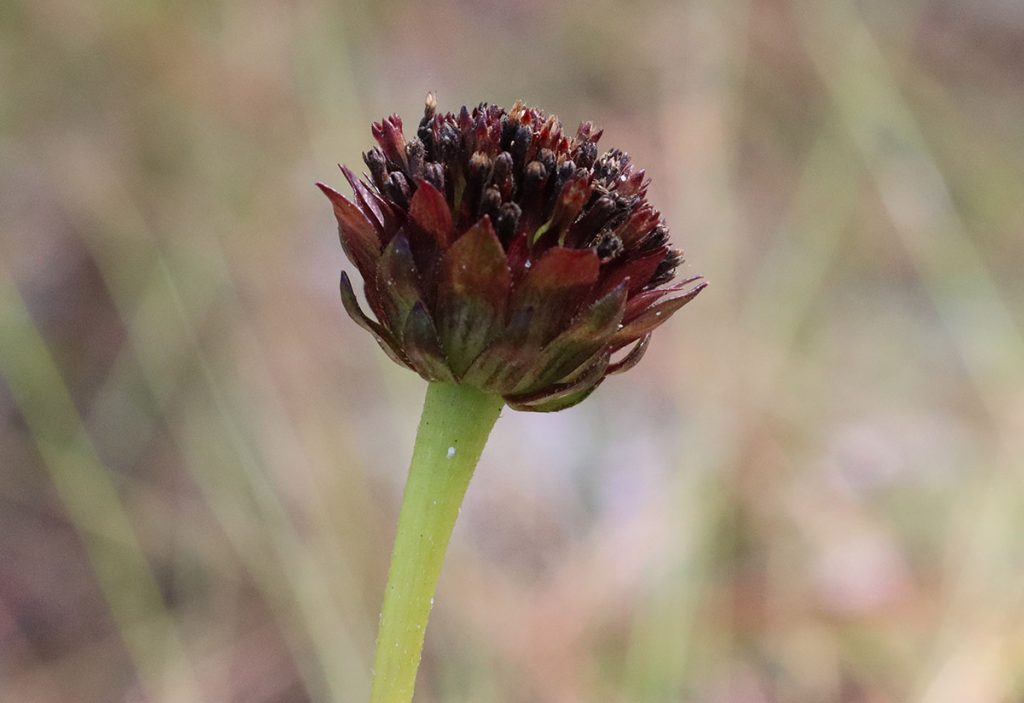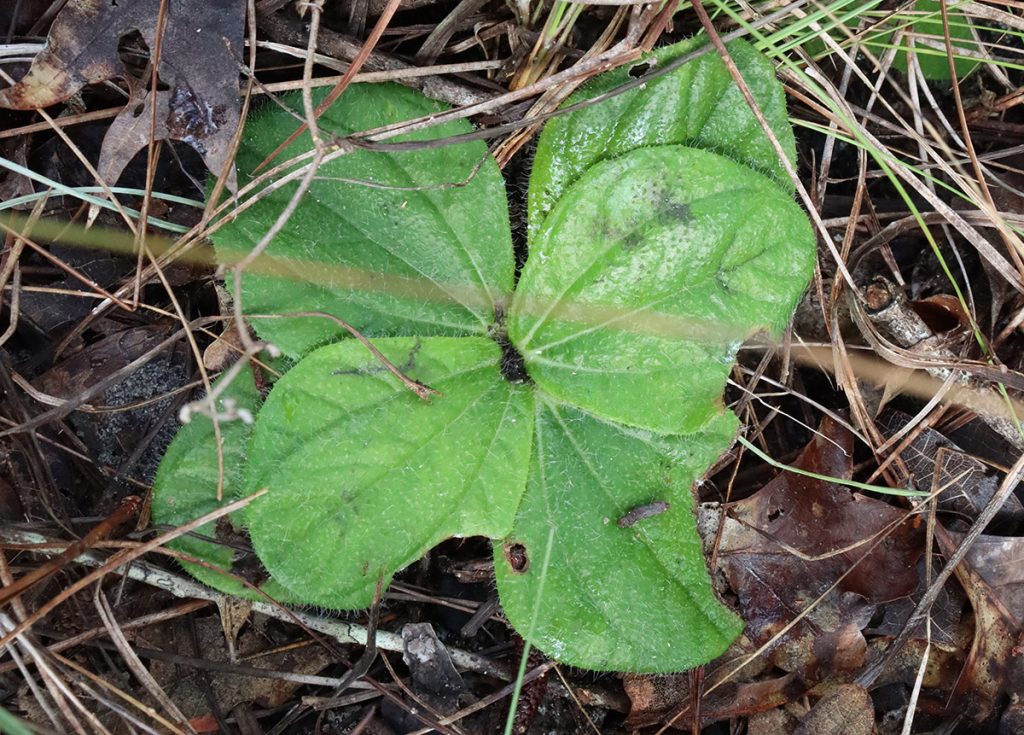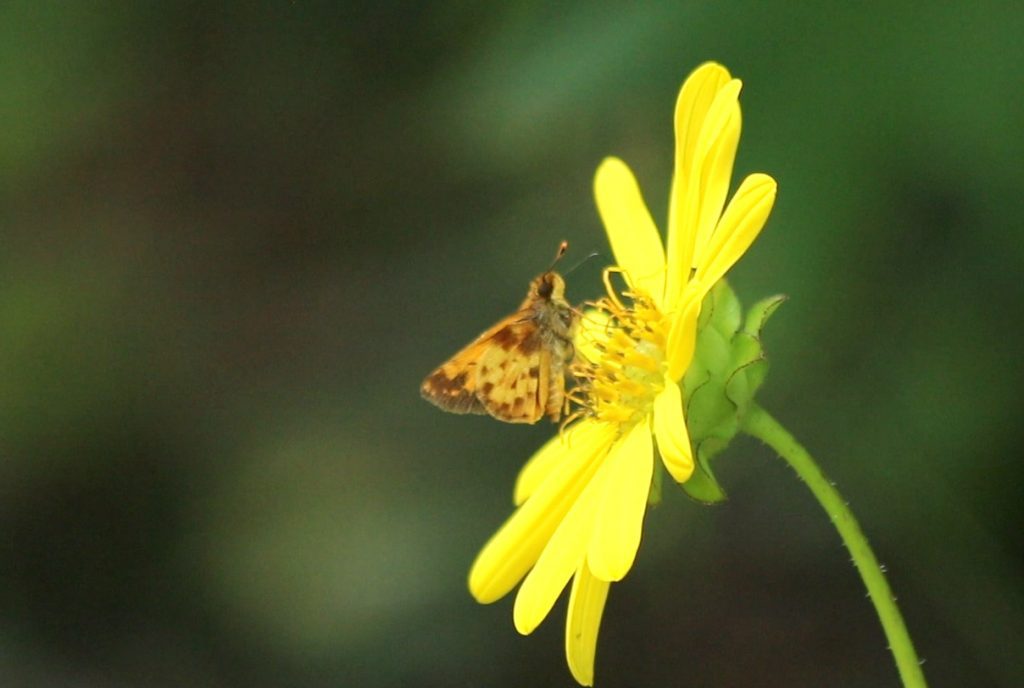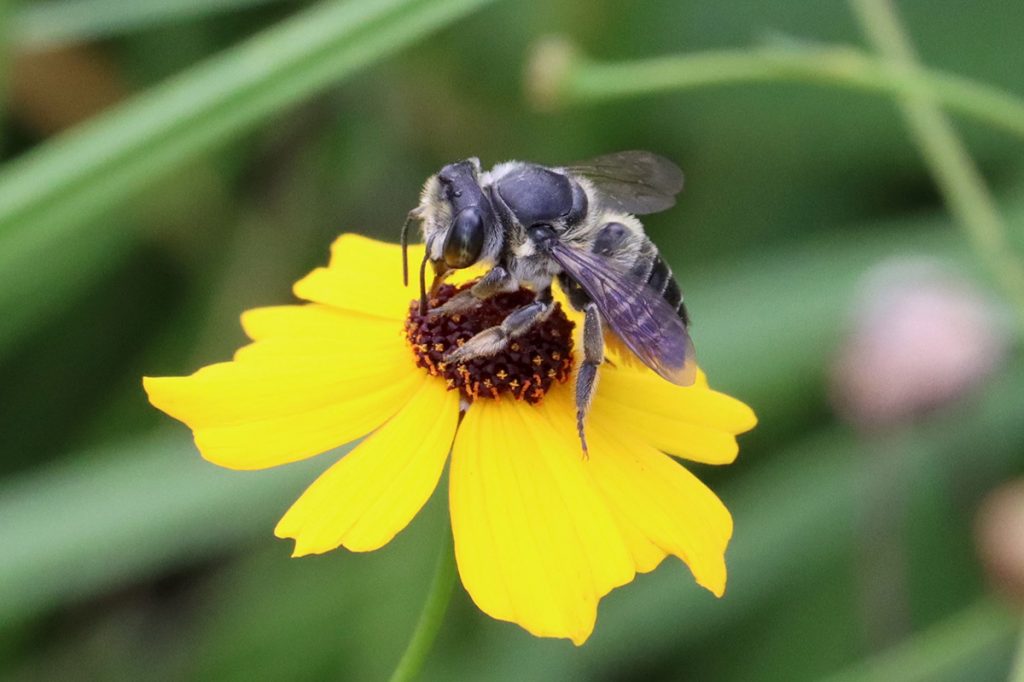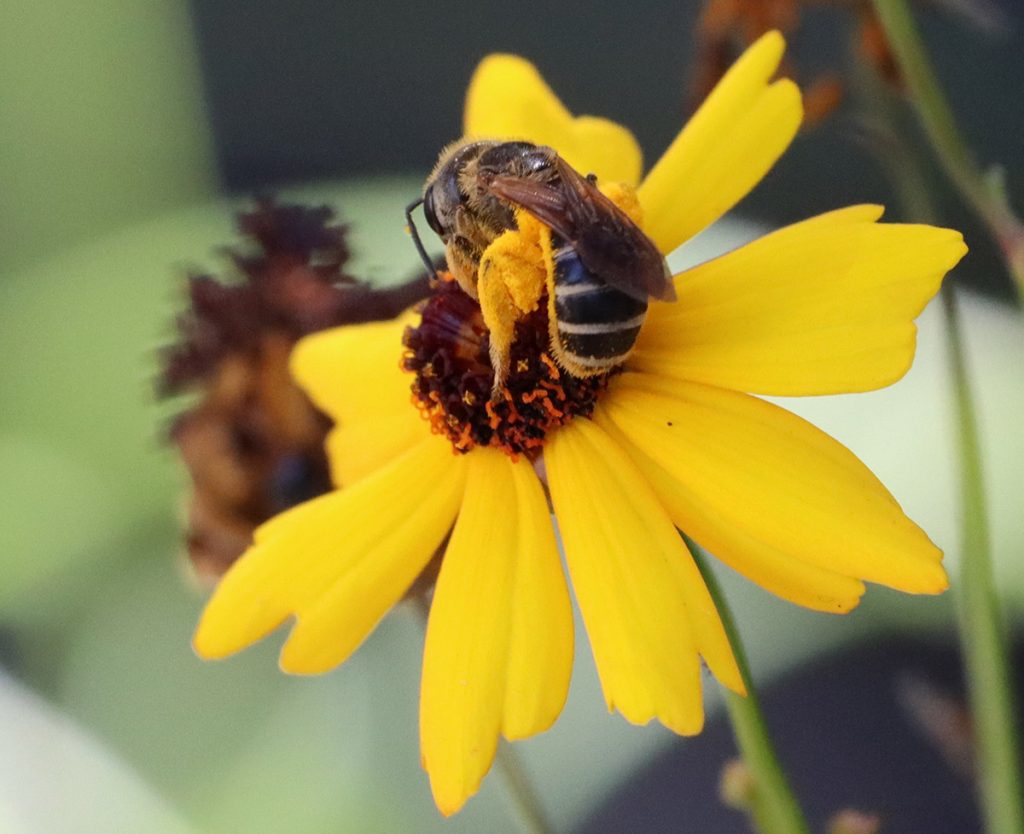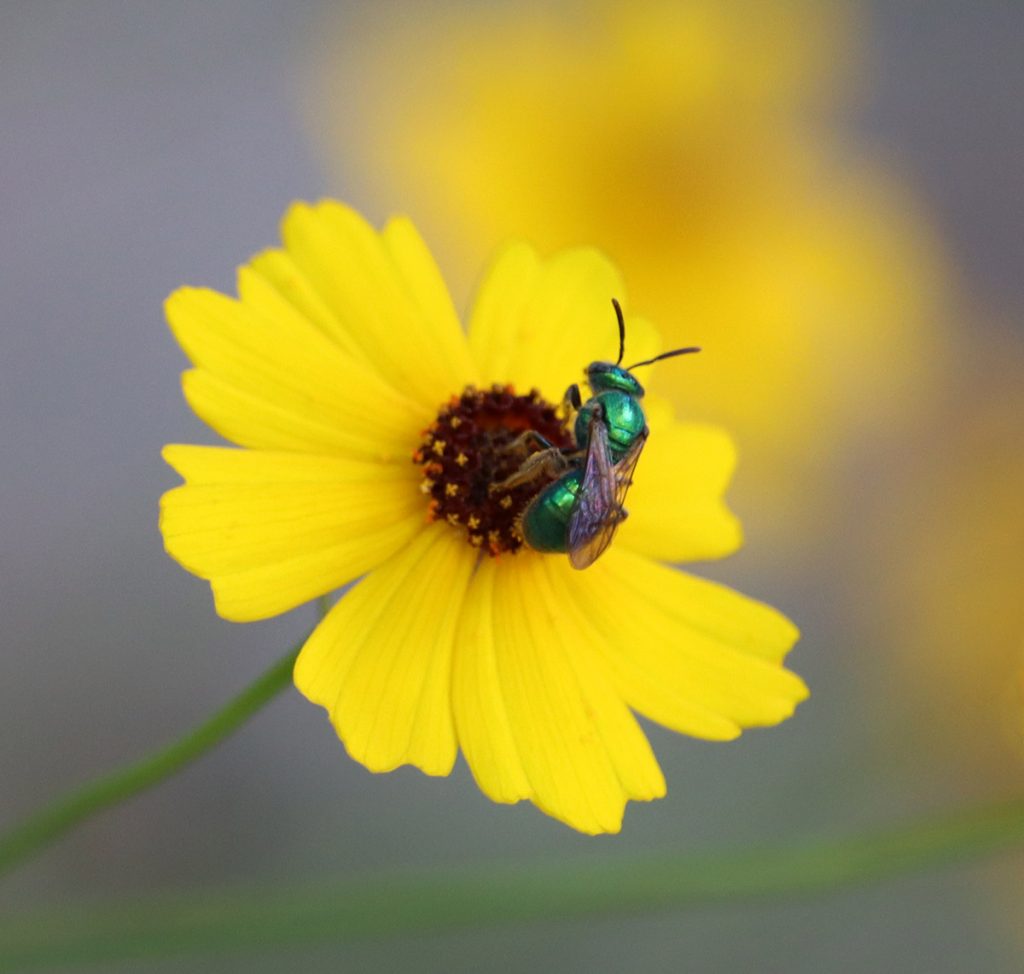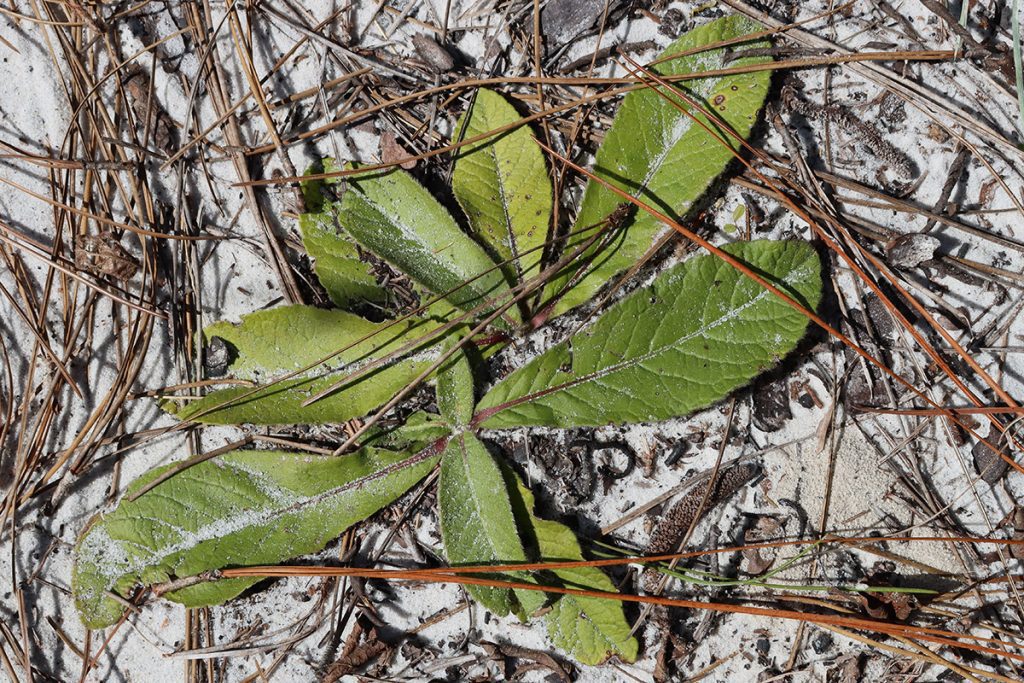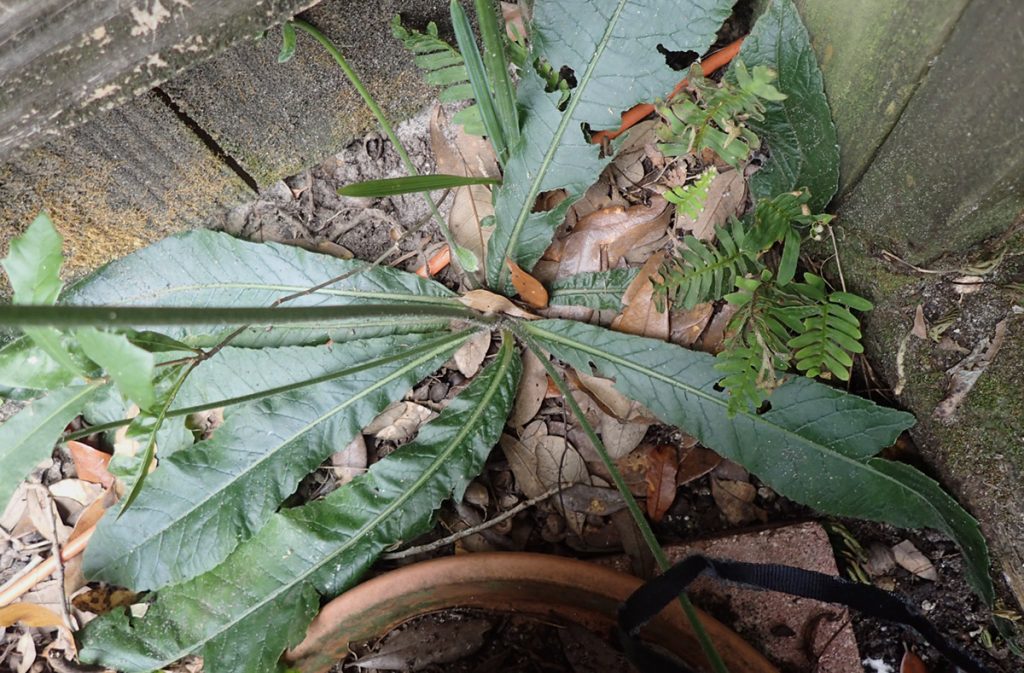Learn about the many Florida native plants you can include to create a bee habitat in your yard. Also, WFSU is giving away wildflower seeds starting in February of 2022 (while supplies last) as part of Bee in My Garden Days.
Last year, at the peak of the fall wildflower season, I wrote about leaving space in your garden for bees to nest over winter. I wanted to look ahead, to let you know that those wildflowers still helped native bees even after they turned brown and grey. Now, while bees and their larvae sleep in the ground and in those flower stalks, I want to look ahead to when they wake up.
Some bee species emerge earlier in the year than others, and when they do emerge, they will seek out nectar and pollen. What flowers will be there in February and March for mining bees and bumblebees? Are they the same flowers that will feed longhorn bees as spring turns to summer? In August and September, brown-winged striped sweat bees explode in my yard, as do the blue lobelia, dotted horsemint, and Brickellia flowers. A few weeks later, asters and goldenrod provide nectar to mothers prepping nests for the winter.
Making a habitat for bees means providing for them year round. I talked to some of my favorite plant people about this, folks from the Florida Native Plant Society, Native Nurseries of Tallahassee, and the UF/ IFAS Leon County Extension. Between their recommendations, and with a few favorites of my own, I present to you this list of bee-friendly plants.
Where do we start? Not by looking down at your flower beds, but by looking up at trees.
Before Picking Plants, Know Your Habitat
When creating a yard habitat for wild bees, or any native wildlife, we look to mimic natural ecosystems. “The basis of any good habitat is the trees first,” Says Florida Native Plant Society’s Lilly Anderson-Messec, “and in the Panhandle… mature oak and pines are critical, and irreplaceable.”
While bees won’t spend a lot of time looking for nectar in oaks and pines, ideally, these are the trees around which you build. I say ideally because we don’t always have a choice when it comes to trees. You may rent, or have bought a house with established trees. Those trees might be nonnative, like crepe myrtles, or they may be planted in a manner inconsistent with how they’d grow in nature.
I could (and probably should) do a whole other blog post on remaking a tree community in your yard. Here, though, I’ll focus on working with what you have. I am including some trees on this list, for those who have the space.
Start by observing conditions in the different parts of your yard. Where is there full sun, and where is there shade? You may have drier parts of the yard as well as low areas that tend to be more moist. And then there’s soil.
A few months ago, I wrote about native soils in our area, and about a USDA tool that will tell you what soil you have. Lilly warns about the fill dirt used when building homes- you may find that you need to amend your soil and condition it over time.
Armed with knowledge of light, moisture, and soil conditions, you’re ready to choose plants. Over time you will notice how certain plants respond to certain areas; if you keep observing, your garden plans will evolve as you become more in tune with your yard.
Bee Plants: More than Just Wildflowers
So, you’ve identified the spaces where you’re going to plant. Next, you have to decide what to plant.
“A diversity of flowers,” says Mark Tancig, Horticulture Extension Agent at the UF/IFAS Leon County Extension, “Lots of different species, lots of different heights: low things, medium, tall.”
Mark doesn’t just mean low, medium, and tall wildflower species. Those herbaceous wildflowers aren’t the only native plants whose flowers attract pollinators. Says Native Nurseries owner Elizabeth Georges, “You want to plant a diversity of native wildflowers, and native trees and shrubs: something like blueberries.”
Blueberries came up often in our interviews. Like many native shrubs, they flower in the early months of the year, before most wildflower species. So they provide nectar and pollen for those bees that emerge earlier in the year, like mining bees. Also like many other native shrubs, some blueberry species can become small trees if they aren’t pruned. That means that, depending on how you manage their growth, they can be used in a variety of spaces. And then, of course, blueberries and other shrubs produce fruit for wildlife (and people, too!).
Trees and shrubs feed bees in the late winter and early spring. After that, you want to make sure you have wildflowers that bloom at all times of year, and whose bloom seasons overlap. The list below includes bloom times for each plant, and includes a couple of weeds that can bloom pretty much year round.
Now, the good part- lots of bee plant recommendations!
A couple of things to note:
- Some of native plants have a wide range, which means they’re more widely available in nurseries. Lilly stresses that you’ll want a plant from local seed stock, as it will be genetically better adapted to our conditions and pollinators.
- Many of these flowers will bloom for a few weeks or months. The rest of the year, they may exist as leafy growth, or underground as roots. Think about how you mix longer and shorter blooming plants for the best visual/ ecological effects.
- You’ll notice that many of the flowers recommended bloom in clusters. In the aster, or composite family, what appears to be a single flower is actually a cluster. “Bees really go after those composite flowers,” Elizabeth says, “which are basically one flower, [an] example would be like a native sunflower, and there are a bunch of tiny little tubes within that actual flower where it contains the pollen, the stigma, and the nectar.”
- Wildflowers are often easy to start from seed. Plant on bare ground, free of grass or weeds, during the winter months. Scatter them on the surface of the soil and press down. I’ve had success starting them in pots and transplanting to garden beds as well.
Information on bloom times and soil and sun requirements from wildflower.org and the Florida Wildflower Foundation.
Trees
Fringe Tree (Chionanthus virginicus)
Blooms: March through May
Height: 12′- 36′
Part shade; moist, sandy soils.
Wildflower.org has this blooming between April and May, but here is a photo I uploaded to iNaturalist in March of 2019. The tree’s unusual flowers left enough of an impression that I remember noticing the plant in bloom in Tallahassee when I got back from that camping trip. Something to keep in mind for any seasonal information you find on plants online: seasons vary from year to year, and Florida’s warmer temperatures mean that plants and animals here may have a different seasonal schedule than they do in the rest of the country.
From what I read on the plant’s Florida Wildflower Foundation site, bats pollinate the flowers as well as bees. Both males and females flower, but you need both for females to produce fruit.
Carolina Cherry-Laurel (Prunus caroliniana)
Blooms: February through April
Height: 15′- 36′
Sun/ part shade; moist, loamy soils.
This tree may be over-represented in Tallahassee’s urban canopy. In our 2019 look at Live Oaks and our urban forest, we learned that, according to Tallahassee’s Urban Forest Master Plan, the Carolina Cherry Laurel is our most numerous tree, making up 15% of the canopy. The foresters we spoke with for the piece told us that, in a healthy urban forest, no single species should exceed 10%.
I include this tree because a lot of us have it in our yards, and it does have significant value to pollinators and migratory birds such as robins and cedar waxwings. It is often planted to form a hedgerow between properties, but given space, they can grow into taller trees. I see both examples in neighboring yards.
To maintain urban biodiversity, consider buying another tree species. If you already have it, however, know that this is a tree that is nurturing wildlife in your yard.
Flowering Dogwood (Cornus florida)
Blooms: March through June
Height: 20′- 40′
Shade/ part shade; moist or dry soils.
Note that this and other trees on this list need some sort of shade. These are understory trees that grow alongside taller trees.
Dogwoods have had trouble growing in Tallahassee due to a blight. However, in a guest blog post to the Tallahassee Democrat, retired Native Nurseries owner Donna Legare suggests that if your yard has ideal conditions, it might be worth giving dogwoods a chance.
Palms/ Palmettos
“A lot of folks don’t think of palms as being very flowery or very helpful for pollinators.” Says Mark Tancig. “But they are, in fact, very useful. Their blooms come out more in the springtime, you know, later in the spring. And we have several species of native palms.”
Saw Palmetto (Serenoa repens)
Blooms: May through July
Height: 10′- 12′
Part shade; well drained soils.
I came upon the flowers in the Palms banner image last year at Nokuse Plantation. I admit that, like Mark says, I had never noticed palmettos flowering before. So when Turtle Bob Walker pointed it out, I was surprised to see and hear so many bees and wasps on its flowers.
We’ll see it time and again on this list- here is a plant we often see as a shrub in fire dependent longleaf pine ecosystems. Like all shrubs in a longleaf savanna, they can reach maturity within the 2-3 years between fires, and thrive and even reproduce at a smaller size. Without fire (or hedge clippers) to limit their growth, saw palmettos can grow to ten or twelve feet tall. This makes them adaptable to different sized spaces.
Bluestem Palmetto (Sabal minor)
Blooms: May through June
Height: 5′- 10′
Part shade; moist soils (sandy to clay)
“This is a great addition,” Mark says, “especially have a shady area.” This is a smaller palmetto that grows in wetter, shadier places than saw palmettos. An IFAS document on bluestem palmettos recommends planting four to six feet apart for dense ground cover.
Cabbage Palm aka Sabal Palmetto (Sabal palmetto)
Blooms: June through July
Height: 30′- 40′
Part shade; sandy soils
Hollies (Ilex)
“The hollies are really important for early emerging native bees that come out in spring.” Lilly says, “These species bloom in spring, and they have prolific blooms… the bees just love them.”
Hollies are better known for their bright red berries than their flowers. Many Ilex species can be shrubs or trees, and different species bloom at different times of year. So you have a few options for a plant that helps bees and birds.
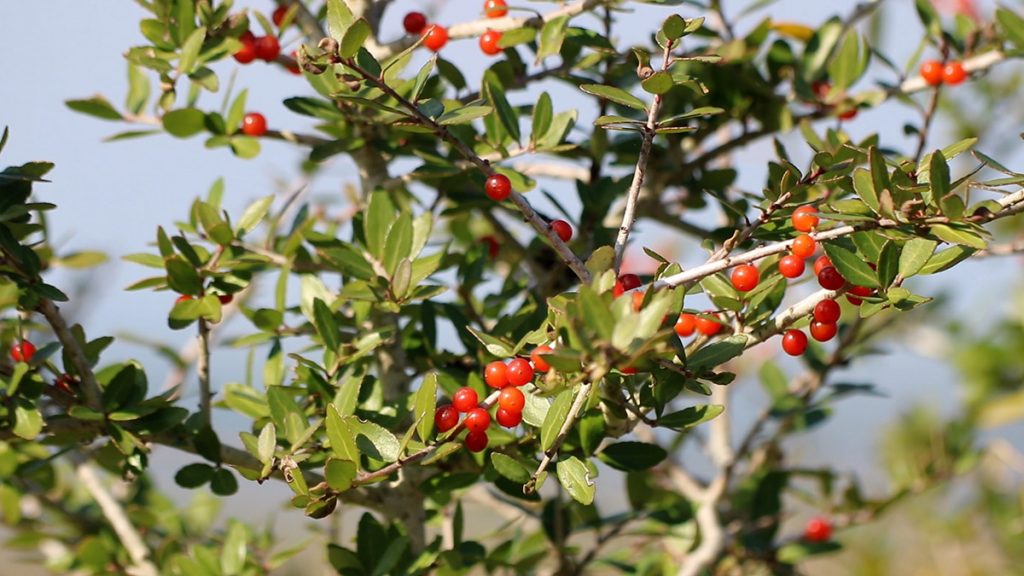
Yaupon Holly (Ilex vomitoria)
Blooms: March through May
Height: 12′- 36′
Part shade; moist, sandy soils.
Lilly and I encounter a small yaupon holly while walking through the Apalachicola National Forest. It could grow to tree size, but here in a longleaf pine ecosystem, its growth is checked.
“These are being maintained by fire. They’re small because because they keep burning in this area,” Lilly says. Much like fire keeps yaupon hollies small in the forest, you can choose at what size you want to maintain them. “You can trim them into hedges if you wanted to. They’re pretty adaptable. They do send up little runners so they can form thickets and be a little weedy in some areas.”
The leaves have a use with deep roots in our area.
“The leaves have a high concentration of antioxidants and caffeine.” Lilly says. “And they have been used by indigenous people for a very long time as a resource for caffeine.”
The leaves were used to brew “the black drink” by the Apalachee people who lived here when the Spanish colonized Florida. The drink was used in purification rituals, such as those conducted on the nights before villages faced each other in the Apalachee ball game.
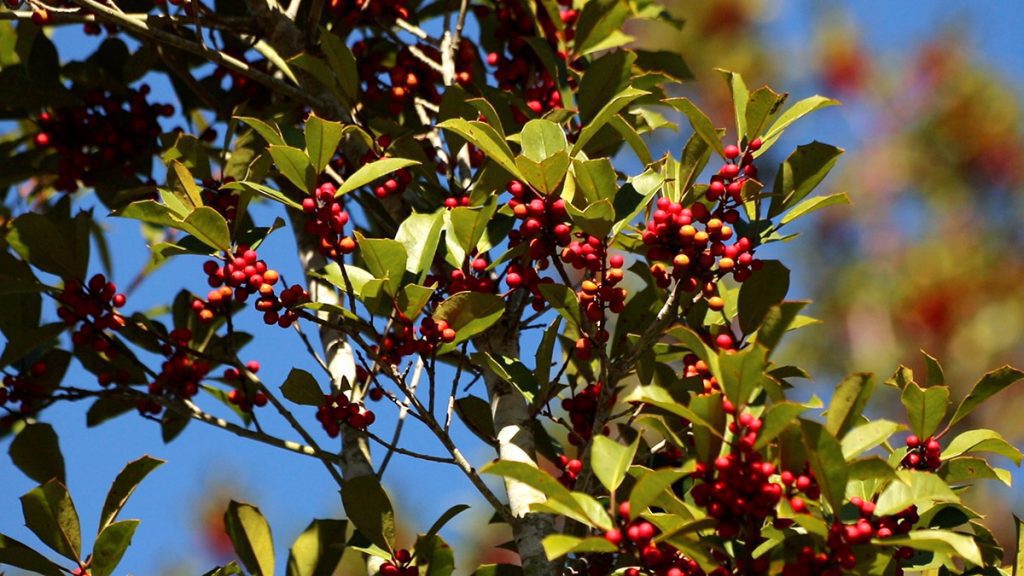
American Holly (Ilex opaca)
Blooms: March through June
Height: 25′- 60′
Sun or shade, in any soil but clay.
This is a full sized tree, but there are varieties bred to be used as shrubs.
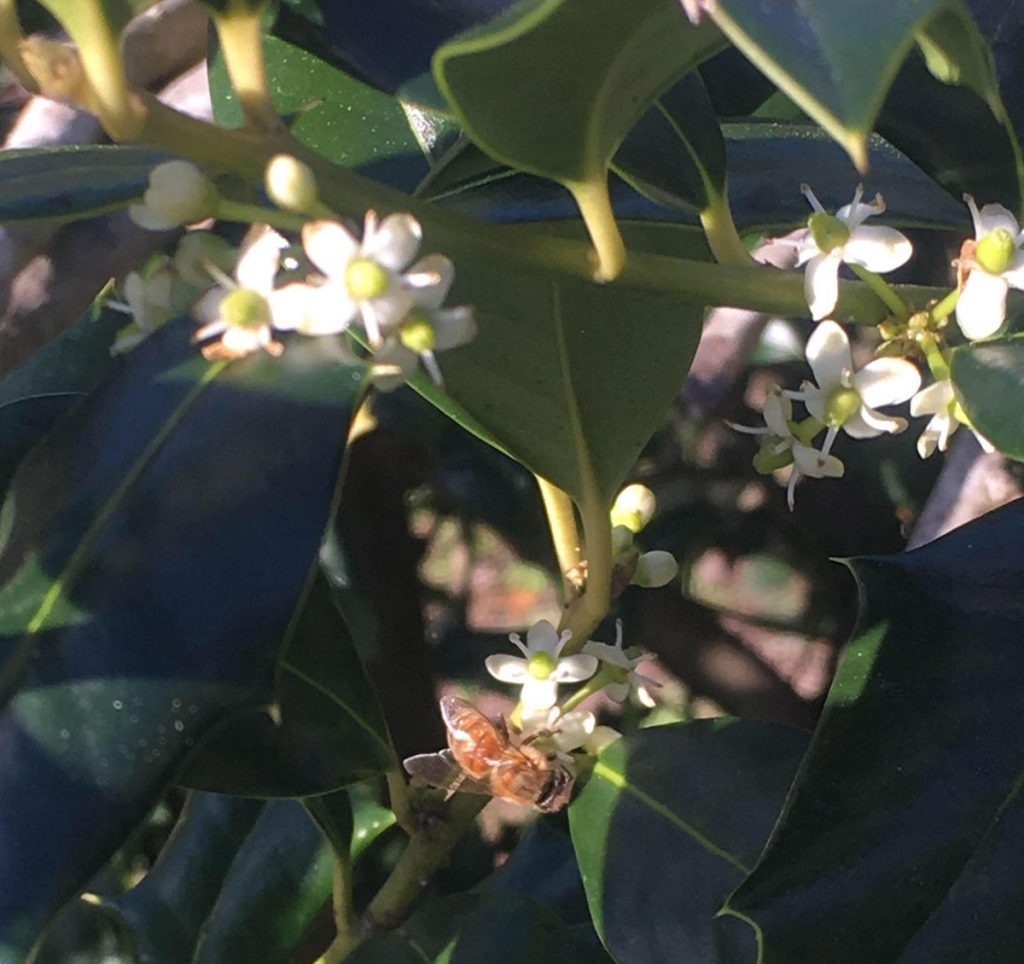
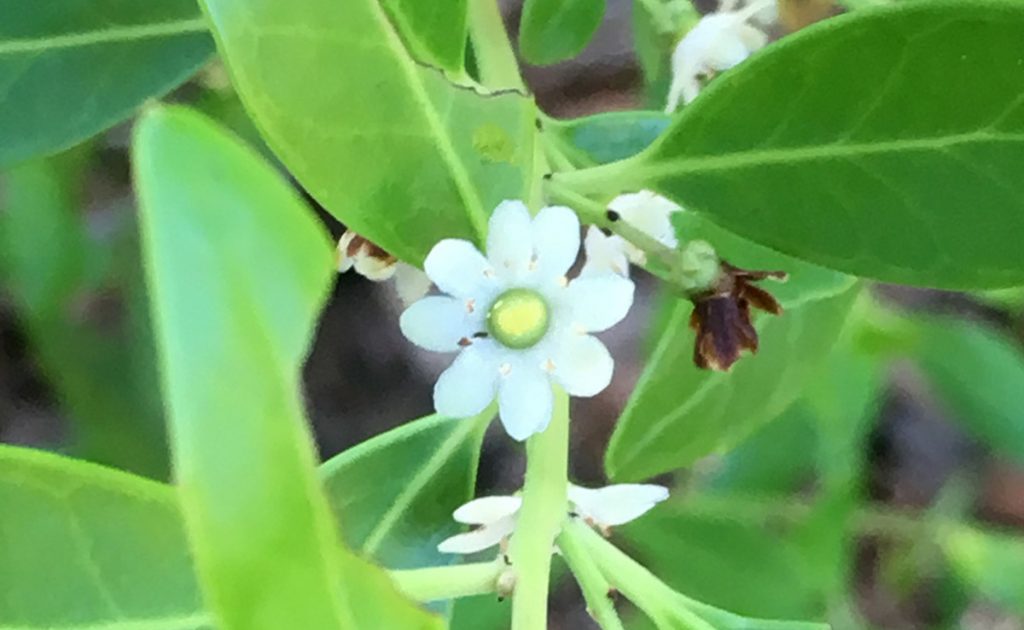
Gallberry (Ilex glabra)
Blooms: June through September
Height: 6′- 12′
Part shade, moist soils.
The My Garden of a Thousand Bees project focuses on wild, native bees. And they will visit this plant. This is also, however, a plant of interest to commercial beekeepers, who place their hives near it to produce gallberry honey.
Blueberries
(Vaccinium)
Elizabeth Georges sent me a list of six native blueberry species available in the nursery trade. One species has the largest and tastiest fruit for human consumption. The others are edible, but less delicious, though the berries can still feed wildlife. And of course, early emerging bees will seek out the flowers.
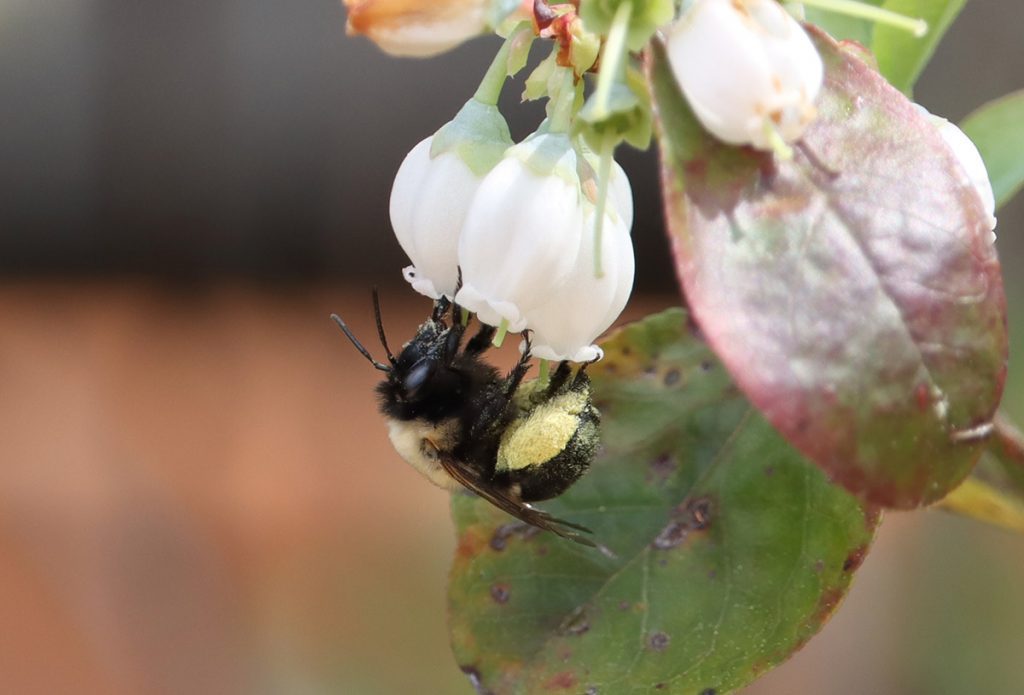
Rabbiteye Blueberry (Vaccinium virgatum)
Blooms: March through June
Height: up to 15′
Sun or shade; sandy soils.
These are the blueberries we grow to eat. Elizabeth tells me that Native Nurseries carries eight to ten varieties of rabbiteye blueberries, and that you need at least two varieties for them to produce fruit.
According to IFAS’s blueberry planting guide, this is the best time of year to plant blueberries in Florida. They recommend mulching with pine bark.
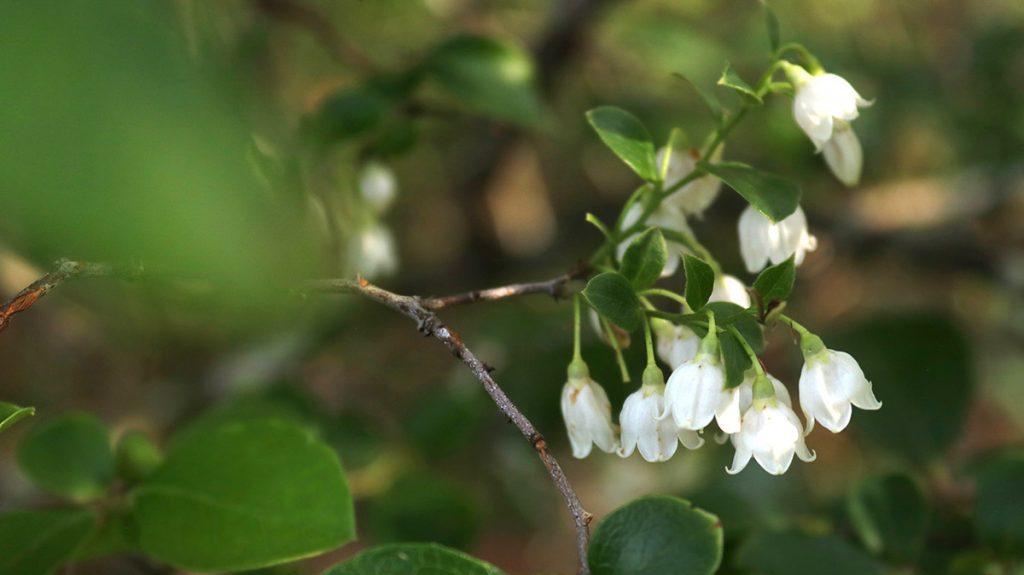
Sparkelberry (Vaccinium arboreum)
Blooms: March through June
Height: 12′- 15′
Part shade; dry, sandy soils.
Lilly and I find two sparkleberry plants in the Munson Sandhills of the Apalachicola National Forest. The first is a small shrub. “When it is allowed to grow- again, this habitat has been fire maintained- so these woody plants like this sparkleberry are being kept low. But it will bloom prolifically, and [in the absence of fire] become a small little tree.”
A little further down the trail, in an area more shaded by hardwood trees, Lilly spots a taller sparkleberry. Fire has been excluded from this spot near Munson Slough, and the same species of woody plants that are shrubs just a few feet away, are trees here. Depending on how you choose to manage it, sparkleberry could take either shape in your yard.
Other Commercially Available Blueberry Species:
Deerberry (Vaccinium stamineum), Mayberry (Vaccinium elliottii), highbush blueberry (Vaccinium corymbosum).
Other Shrubs
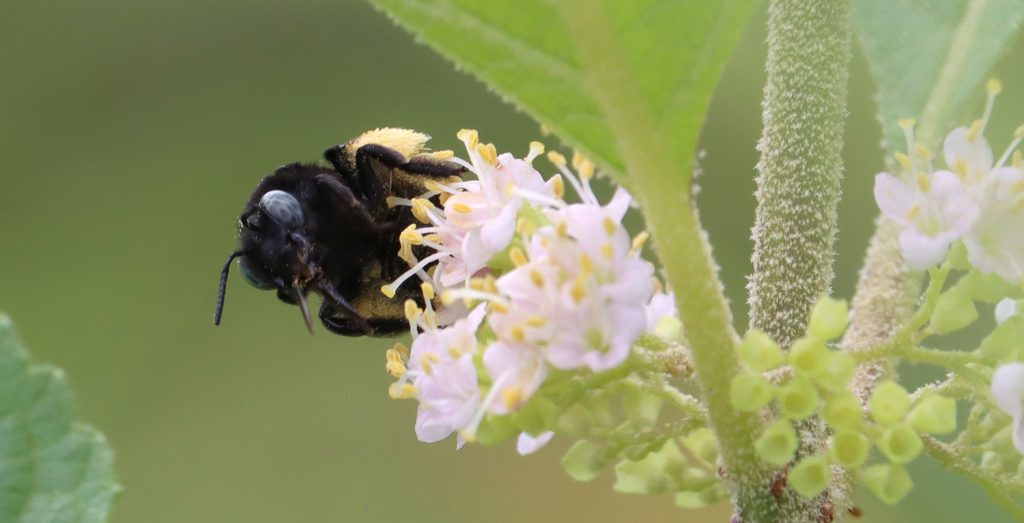
Beautyberry (Callicarpa americana)
Blooms: May through July
Height: 3′ to 6′
Part shade; moist soils.
You may notice a pattern: plants known for their conspicuous berries produce clusters of flowers popular with bees. Beautyberry is a plant for birds and bees, and it adds color to your yard.
Here’s a plant that may already be trying to grow in your home ecosystem. I’m a big proponent of letting weeds grow until you can identify them, and I wrote a post about doing this last year. A beautyberry sprout will show leaves like those in the photo above before it gets too big. If it’s not in a spot that works for you, you might try transplanting it.
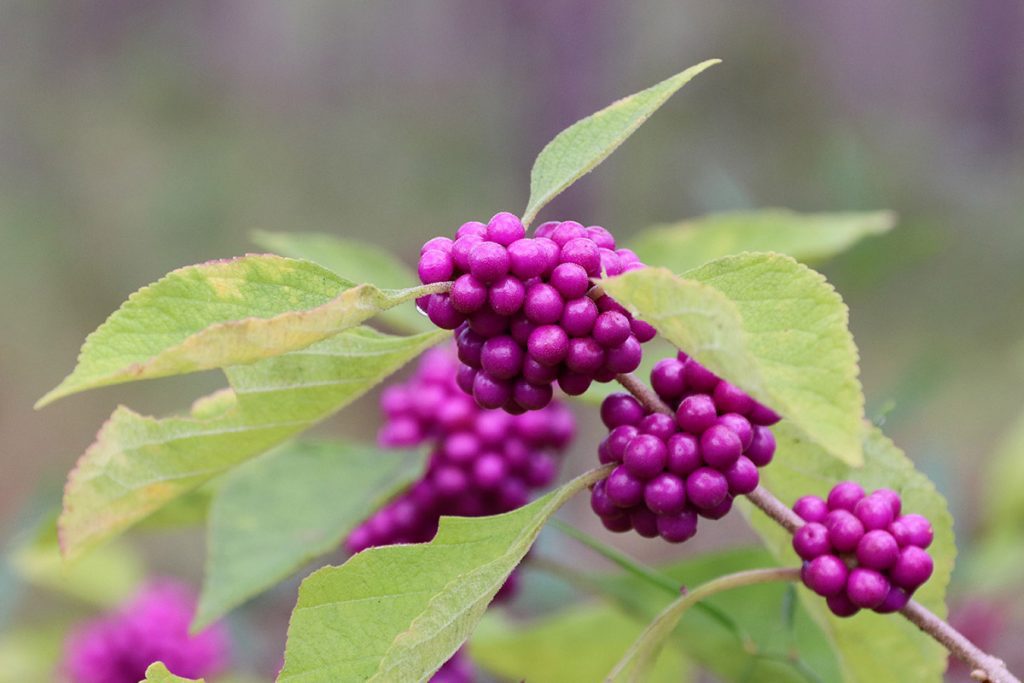
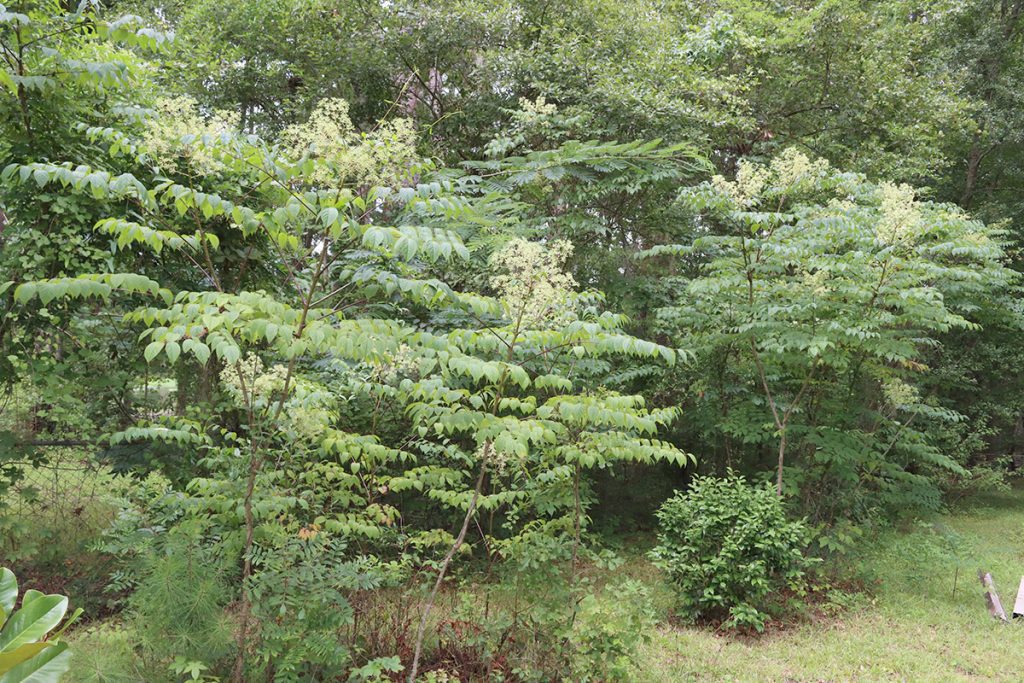
Devil’s Walkingstick, aka Hercules Club (Aralia spinosa)
Blooms: June, July
Height: 12′- 15′
Moist soils, part shade
None of our bee plant partners mentioned this plant, but I had to include it. I produced a video on Aralia spinosa last year after witnessing the sheer number of bees and wasps that visited it in a friend’s yard (you can see the Lammers’ yard, and its impressive expanses of Bidens alba, in this video as well).
There’s a lot about this plant that people find undesirable. It has a thorny trunk, and it spreads vigorously by rhizomes and suckering. For much of the year, it’s not much to look at. But, for a couple of weeks in July, this plant goes insane. Devil’s walkingstick peaks just as dotted horsemint (Monarda punctata) starts to take off, and many of the same bees and wasps rabidly visit both plants.
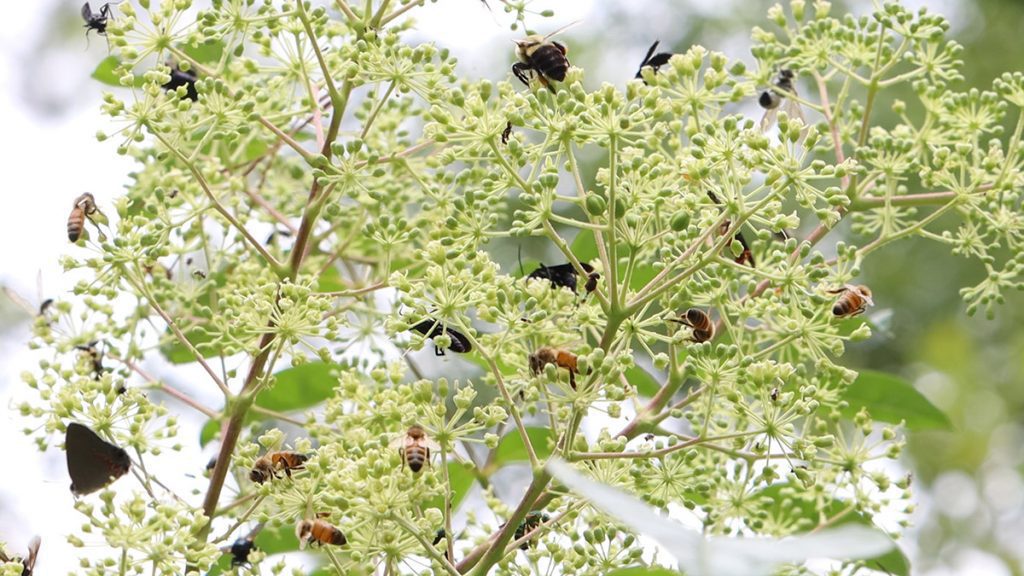
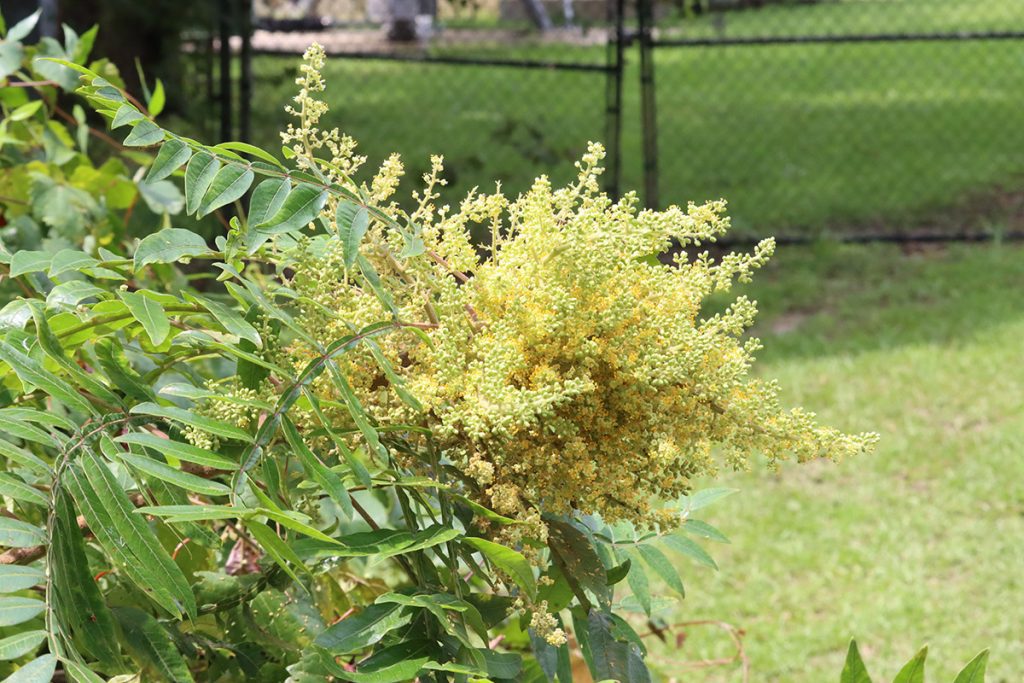
Winged Sumac (Rhus copallinum)
Blooms: July, August
Height: as tall as 20′- 25′
Dry, rocky soils
Another shrub that might be trying to grow as a weed in your yard, and which has adapted to grow as a shrub in fire dependent ecosystems. This is a plant that spreads vigorously by suckering, continuously sending up new shoots from its roots, and expanding its footprint. It’s a plant to consider if you have space, or the time and will to control it.
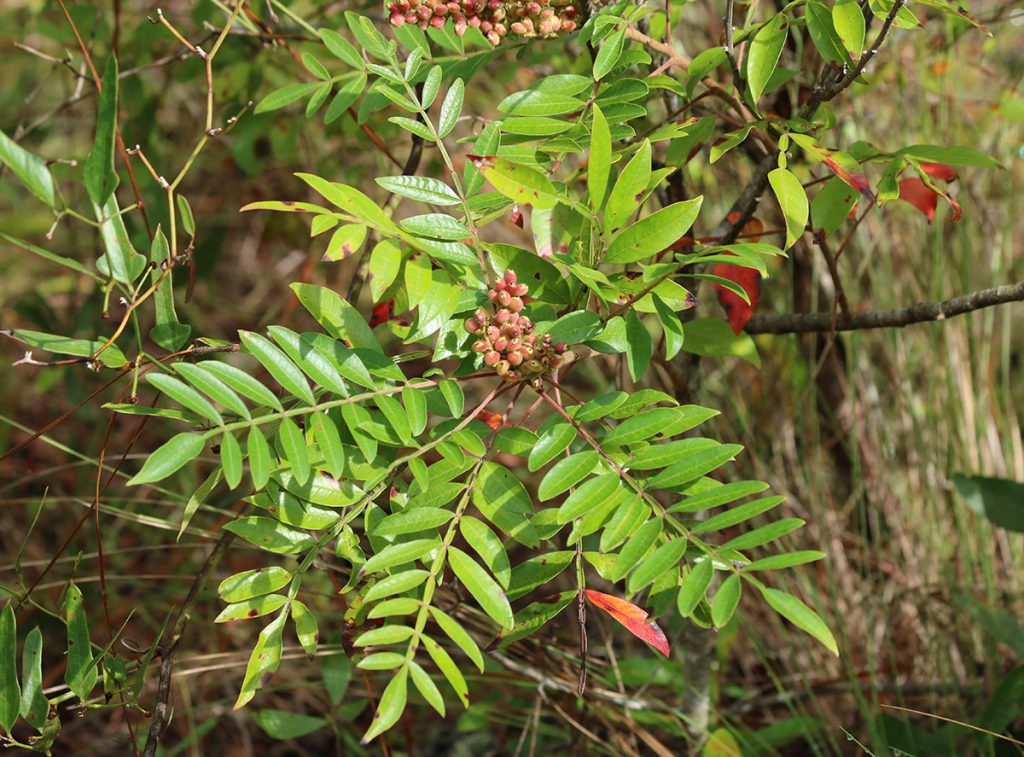
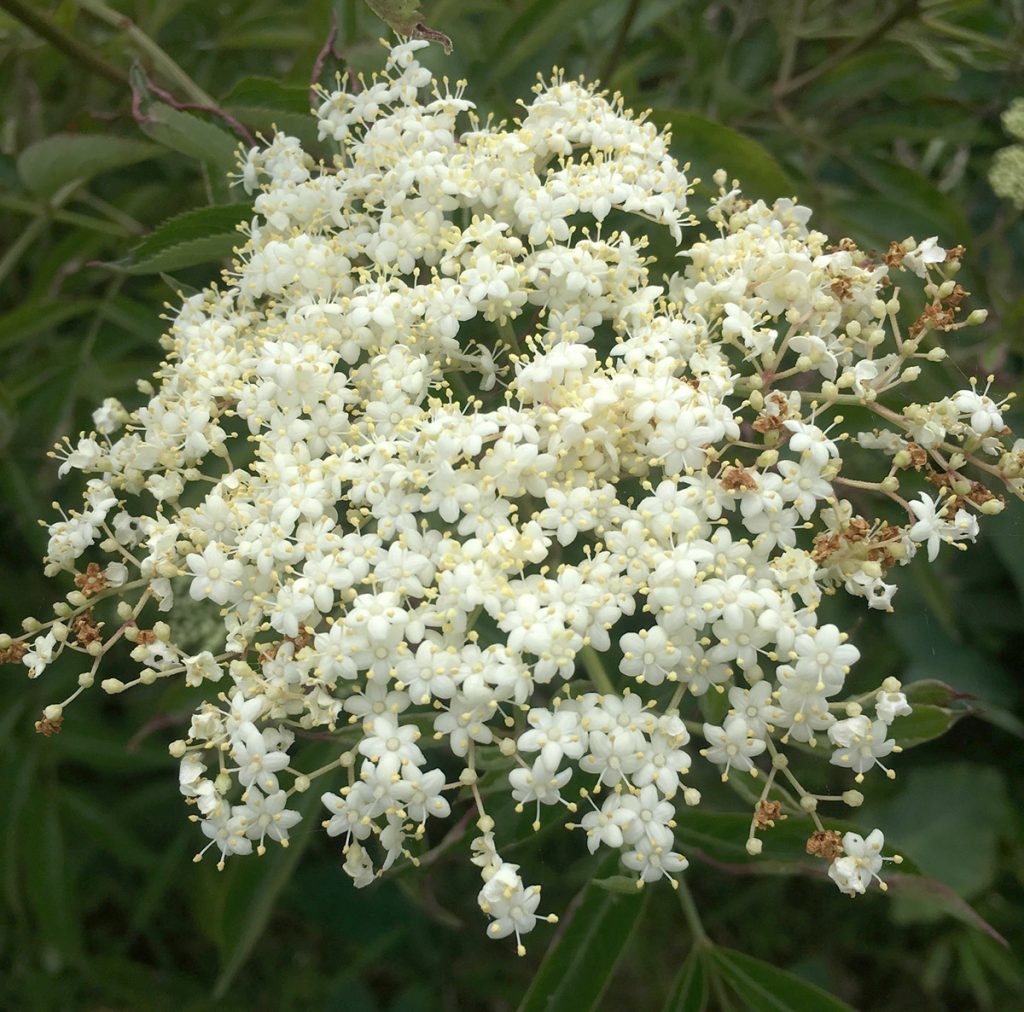
Common Elderberry (Sambucus canadensis)
Blooms: May, June
Height: up to 12′
Part shade; moist soils.
Elizabeth mentioned this as a key plant species for native nesting bees, which burrow into its hollow stem. In the late spring, it also produces clusters of flowers. The berries attract birds, and are used medicinally by humans.
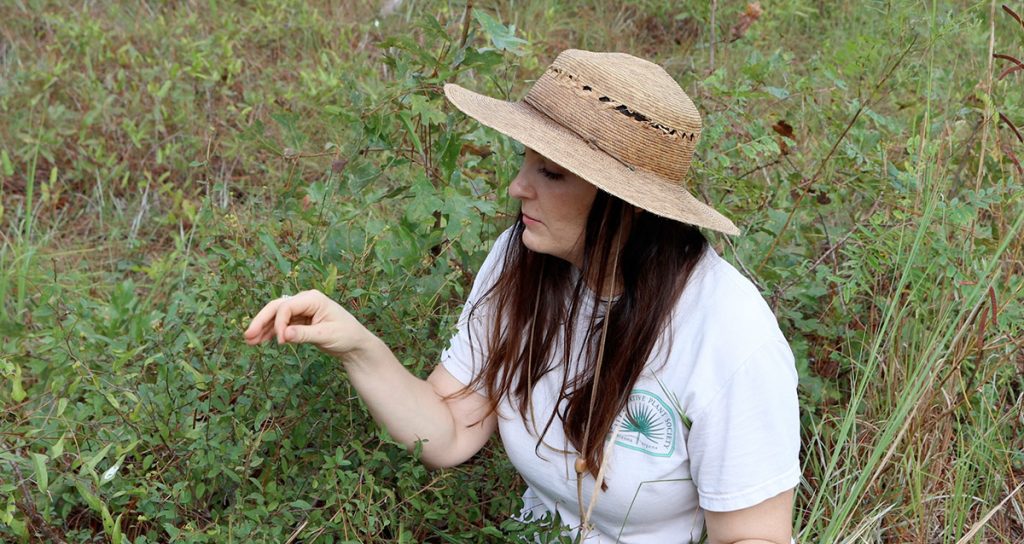
New Jersey Tea (Ceanothus americanus)
Blooms: March, April
Height: up to 1′ to 3′
Shade/ part shade; dry or moist soils.
Here’s another shrub for early emerging bees .”This plant has these clusters and multiple blooms and spring,” Lilly says. She also shares a historical fact about the plant. When American colonists boycotted British Tea in protest of its taxation, they used the leaves of this plant as a tea substitute.
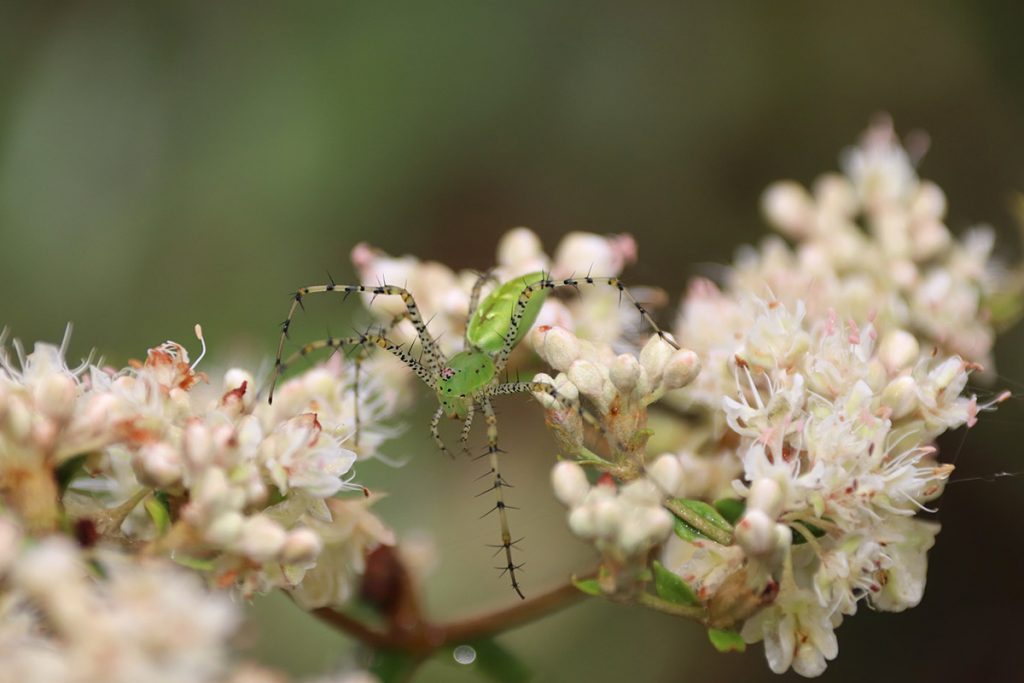
Sandhills Wild Buckwheat (Eriogonum tomentosum)
Blooms: May through October
Height: 18″
Full sun, dry soils.
Lilly spots a green lynx spider on a cluster of white flowers. I’ve only ever seen these spiders on flowers, waiting for unsuspecting pollinators. The plant is sandhills wild buckwheat, a common shrub in the sandhill habitat.
“This is a very common species to see in sandy soils in Florida.” Lilly says. “It’s pretty easy to grow from seed, if you can catch it in seed.”
Wildflowers
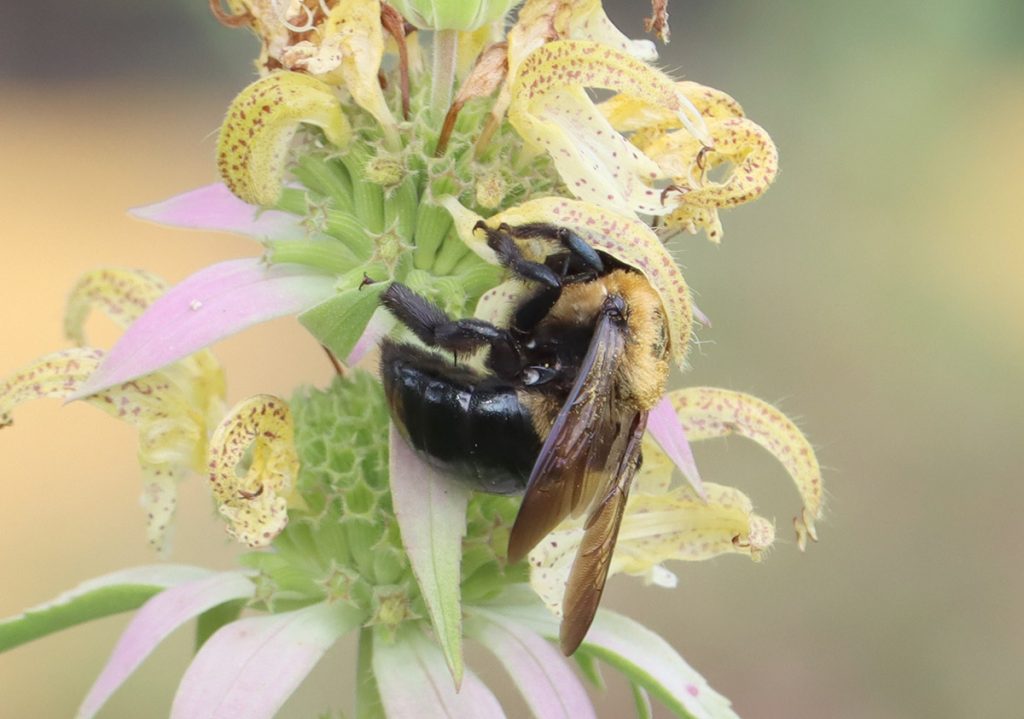
Dotted Horsemint, aka Spotted Beebalm (Monarda punctata)
Blooms: July through September
Height: 1′- 3′
Full sun, dry soils
“If you want to see a plethora of insects that you never see on any other plant,” Elizabeth says, “Monarda is the one that attracts all kinds of really different wasps and even some tiny solitary bees as well, sweat bees.”
This is a plant that came up in every interview. It blooms in the late summer, sometimes lasting towards the end of September. Over the few weeks it’s in flower, pull up a chair and watch. In addition to carpenter bees, bumblebees, and sweat bees, beebalm is a magnet for large, kind of scary looking solitary wasps. Those are, of course, the wasps least likely to bite you, but they are fearsome predators.
It only blooms for a few weeks, but as a member if the mint family, you can enjoy its fragrant leaves almost year round. And, as Elizabeth pointed out in our bee nesting video, if you leave its dead stalks alone in the winter, it’s a potential nesting habitat.
Lilly points out that this is a plant that ranges into Canada. This doesn’t mean you can take seeds from horsemint in Ontario and expect them to thrive in Florida. “Purchasing plants that are from our native Florida seed stock of Monarda is important not just for… providing the right plant for our bees,” Lilly says, “but also for the survival of that plant in your yard. It’s less likely to survive if it came from a Canadian seed stock because, just over time, those populations have been disjunct.”
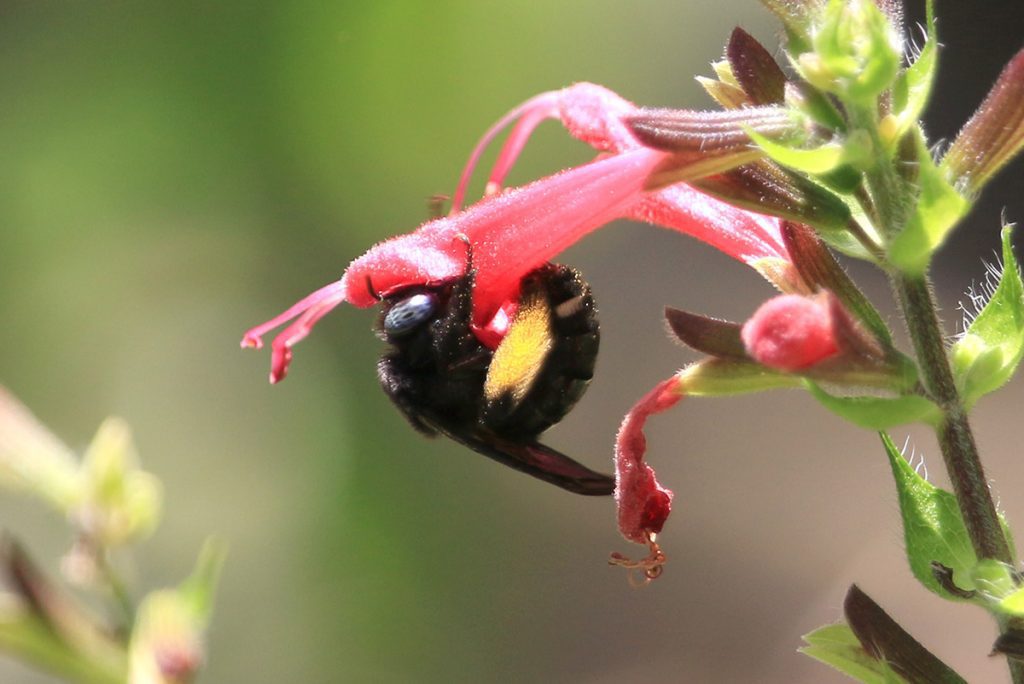
Scarlet Sage (Salvia coccinea)
Blooms: February through October (or longer)
Height: 1′- 3′
Highly adaptable
I added the “or longer” to the bloom dates because until the hard freeze we experienced over the weekend, I still had a few scarlet sage flowers in the yard.
With its long, tubular flowers, this plant is known for attracting butterflies and hummingbirds. It’s also a favorite of larger bees, like longhorns and bumblebees, which hang from the flower and probe it with their probosces. At the other end of the spectrum, I’ve seen ant-sized Dialictus sweat bees land on the stamens and, upside down, walk into the tube for nectar (you can see that in our bee species video).
Another thing to know about this plant. In 2018, I bought two scarlet sage plants. Since then, they have dropped seed and expanded their population to several dozen, possibly over 100 plants.
“It is a little weedy,” Mark says, “so just know that when you plan it, the seeds are going to sit and you’re going to find sage growing out of the cracks of the sidewalk. But it can be easily controlled.”
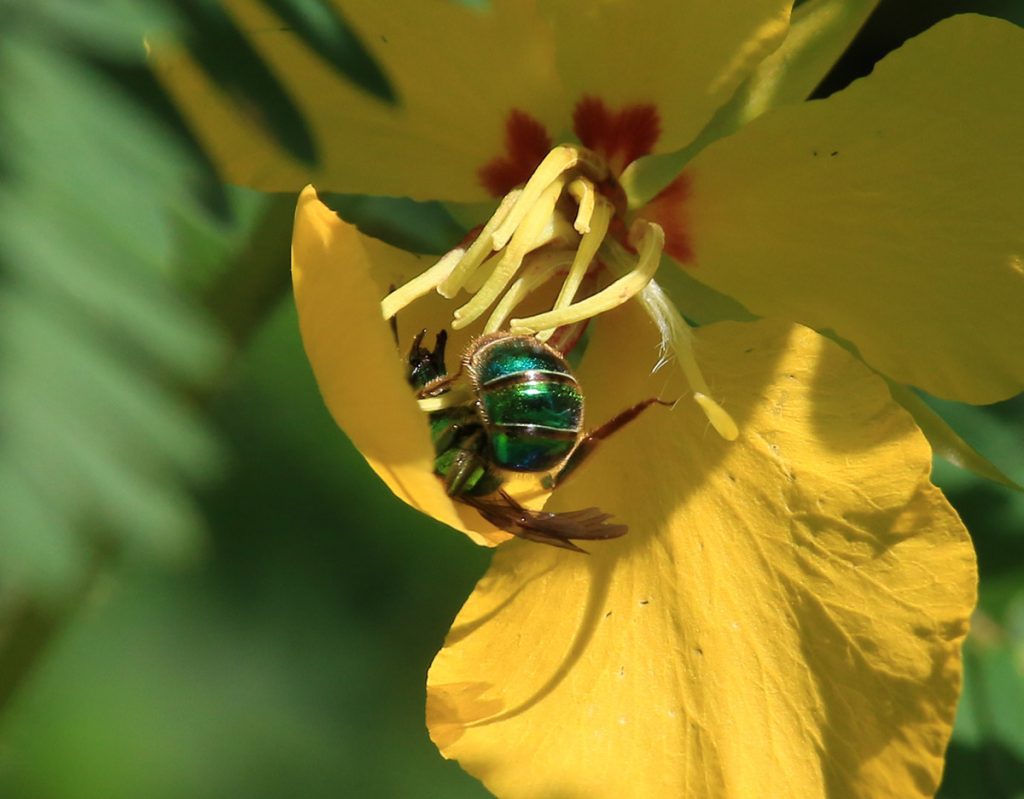
Partridge Pea (Chamaecrista fasciculata)
Blooms: June through October
Height: 1′- 3′
Sun/ part shade, dry or moist soils
Like many of the flowers on this list, this is a butterfly larval host plant. So you can feed bees as well as cloudless sulphur butterfly caterpillars. It’s also in the pea family (Fabaceae), and so it is a nitrogen fixer that will enrich your soil.
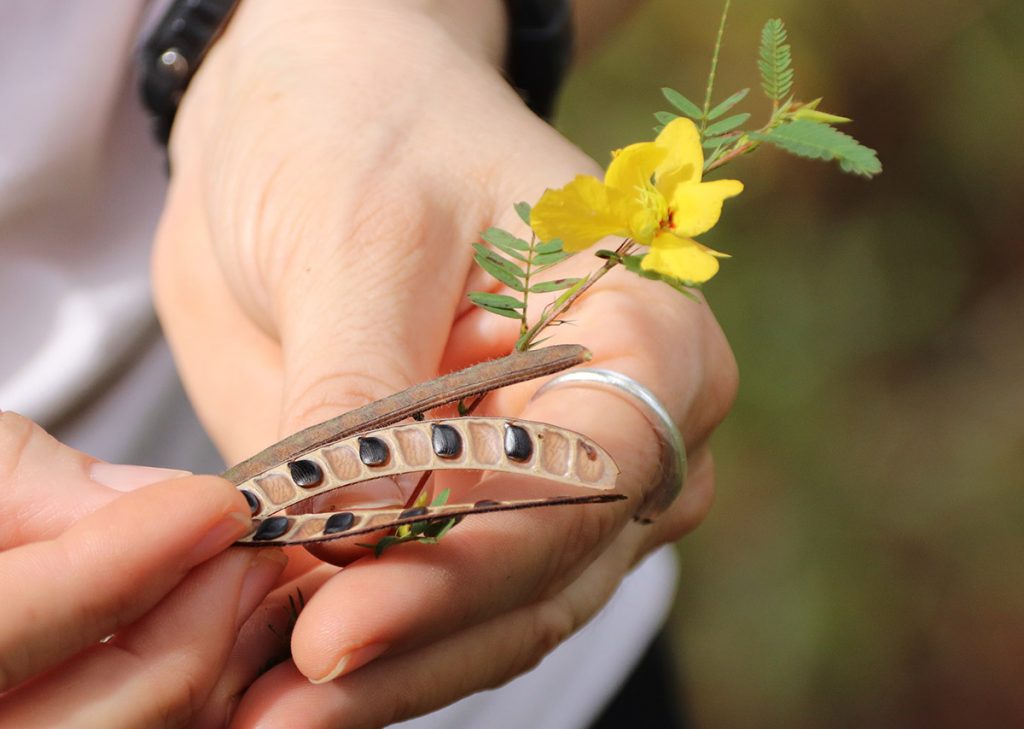
Lilly says this is an easy plant to raise from seed, and seeds are plentiful where the plant is found. I started a plant from a seed pod she handed me on this very shoot in the Munson Sandhills. Seeds from that one plant spread with no help from me, and in year two, we had a dozen or so plants.
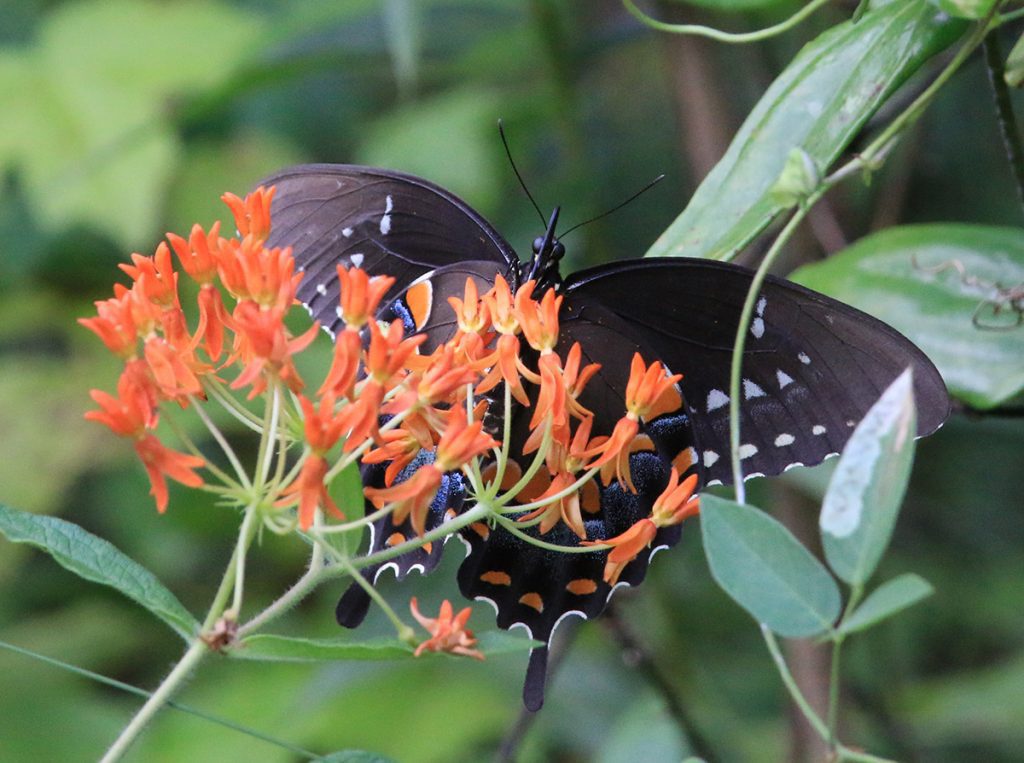
Butterflyweed (Asclepias tuberosa)
Blooms: May through September
Height: 1′- 2′
Full sun, dry or moist soils
“So here we have one of our 21 native milkweed species,” Lilly says. “This is Asclepias tuberosa var. Rolfsii. And this is larval food for monarch butterflies and queen butterflies as well. But a lot of different insects use this species, in particular for its nectar and pollen.”
This is a plant we usually buy with butterflies in mind. But, as we see in the video, smaller sweat bees will visit these flowers. It’s one of the most commercially available of the native milkweeds, along with pink swamp milkweed. Both are widespread species, Lilly says, so there is more plant stock. But she recommends buying plants from Florida stock, as they’ll be better adapted to grow here.
To learn more about different milkweed species, and raising it in your yard, read about our visit to the St. Marks Refuge Monarch Milkweed Project in 2019.
Winged Loosestrife (Lythrum alatum)
Blooms: May through September
Height: 3′- 6′
Sun, moist soils
This is a favorite in my yard. It’s where I see some of the less common bee species in the garden, like the cuckoo and leafcutter bees in the photos above. Its tall talks are lined with tiny flowers, and bees rapidly hop from one to the next. It can be a pain to photograph them on loosestrife, and always a relief when they move to composite flowers like rosinweed, on which they take their time.
I also see a variety of butterflies on winged loosestrife, from duskywings to gulf fritillaries.
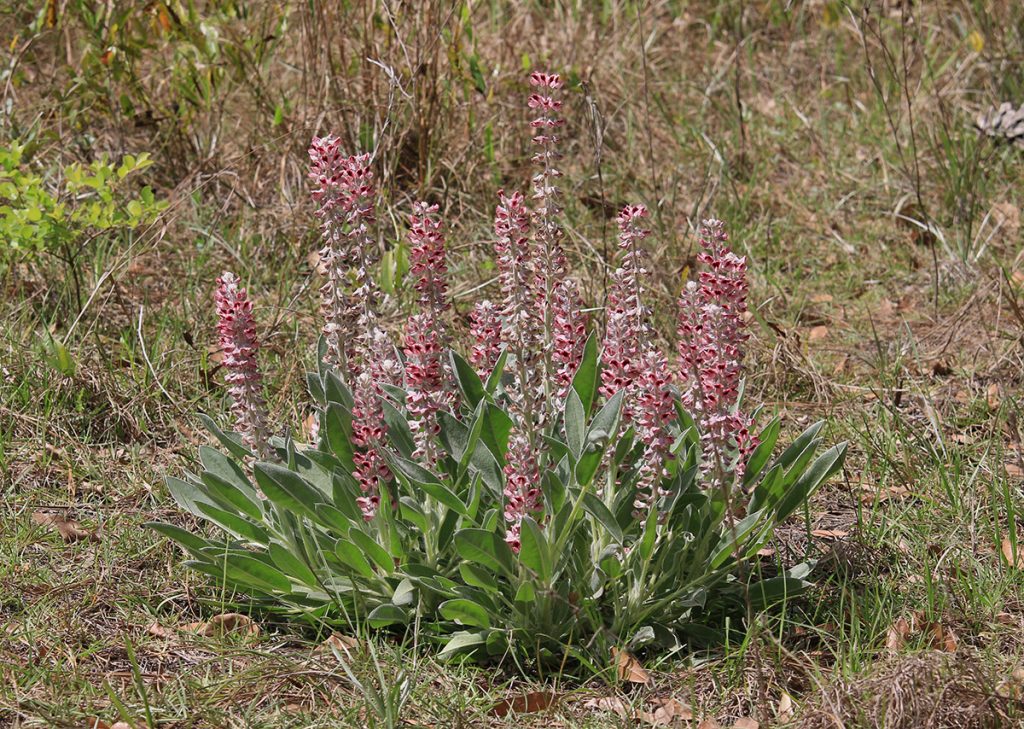
Lady Lupine (Lupinus villosus)
Blooms: March through June
Height: 1′- 2′
Full sun/ part shade, sandy soils
Walking around the Munson Sandhills in September, Lilly spotted a cluster of soft, velvety leaves.
“They feel like little kitten ears, these leaves,” she said. “And it might not look like much right now, but in spring, it is a very showy plant and it has these tall blooms.”
Lady lupine is an early blooming plant in the sandhill habitat. Not far from here at that moment, as fall was starting, blazingstars were starting blooms that peaked in the early fall. Silkgrass flowers and different milkweeds had been providing nectar through the summer. Each has their season, and together with the other trees, shrubs, and wildflowers in the Munson Sandhills, they support a robust bee habitat.
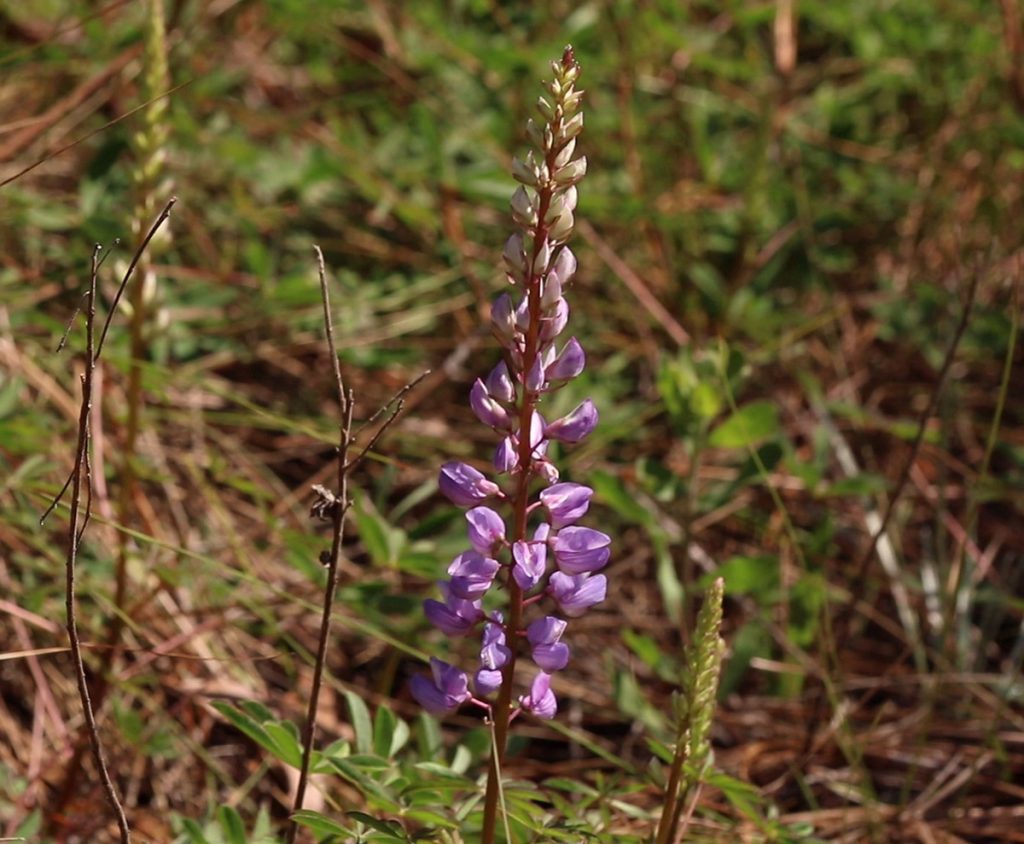
Sundial Lupine (Lupinus perennis)
Blooms: March through June
Height: 1′- 2′
Full sun/ part shade, dry or moist sandy soils
Here’s a plant we got to know as a larval food for the rare frosted elfin butterfly. It’s an early bloomer, and as a Fabaceae, it’s a nitrogen fixer as well. It also happens to be in the wildflower seed packs we’re giving out at the library in February of 2022.
Asteraceae
Earlier, we shared Elizabeth’s quote about composite flowers, the aster family. Looking at the rice button asters above, what look like individual flowers are clusters of flowers. Even the “petals” are other flowers. Bees like composites because they can gather pollen and nectar from multiple flowers at once, without having to expend as much energy on flying.
I still think it’s important to have a variety of flowers in your yard. As Mark says, all shapes an sizes, to accommodate all shapes and sizes of bees and other pollinators.
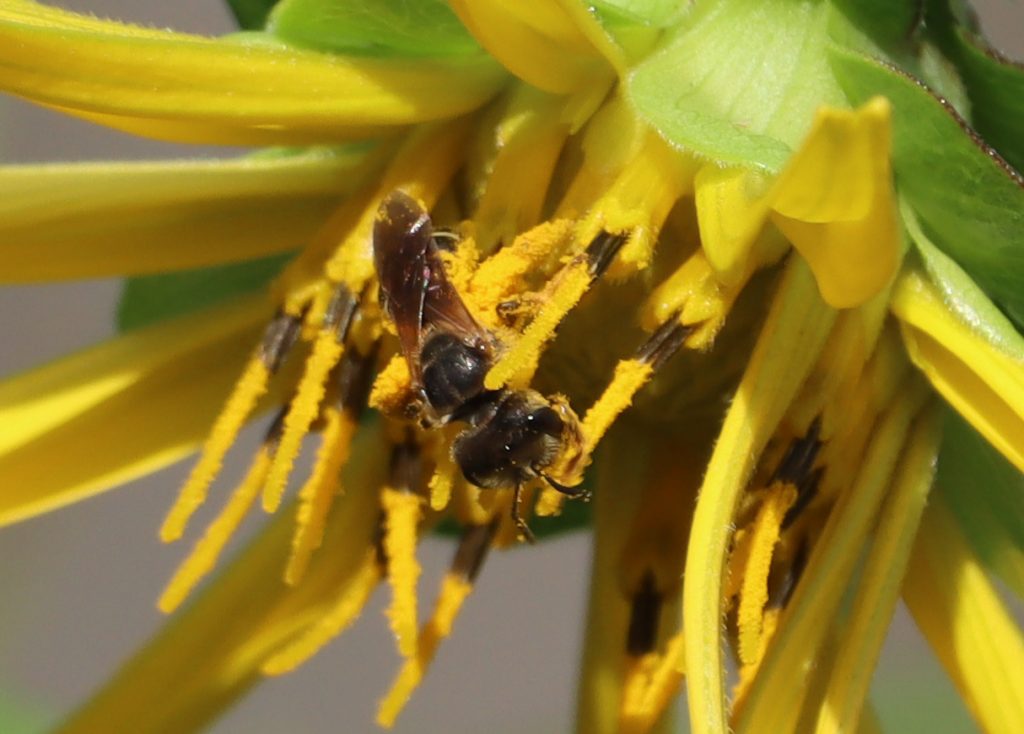
Starry Rosinweed (Silphium asteriscus)
Blooms: June through September
Height: 3′- 6′
Sun/ part shade, dry or moist soils
Gosh, look at the pollen on that furrow bee. I appreciate this flower as a photographer because bees spend a lot of time on it. I love loosestrife, but it’s a challenge keeping up with bees hopping from flower to flower. Rosinweed is where I see bees pig out.
This plant has a reputation as being drought resistant. I bought the one above during a native plant sale that happened to take place during a brutal six-week drought in 2018. I watered it two or three times a day but it still died back within a month. The roots had established themselves, however, and it sprouted up again the following spring. Ever since then, it’s been a hardy plant.
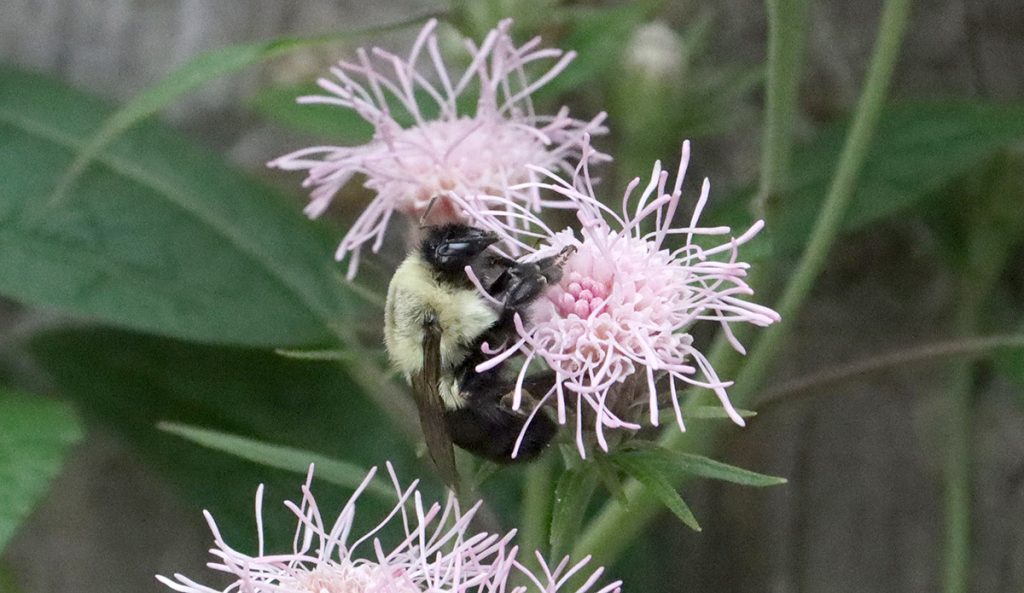
Flyr’s Nemesis (Brickellia cordifolia)
Blooms: August, September
Height: 3′- 6′
Sun/ part shade, dry or slightly moist sandy soils
When WFSU was first awarded the My Garden of a Thousand Bees grant, I immediately took to the garden with a camera. I figured I would end up spending most of my time by the horsemint, and I did see a lot there. But I was surprised that I ended up shooting so much footage of Brickellia. Not because I didn’t already think that it’s an amazing plant, but because I had thought of it as more of a butterfly plant.
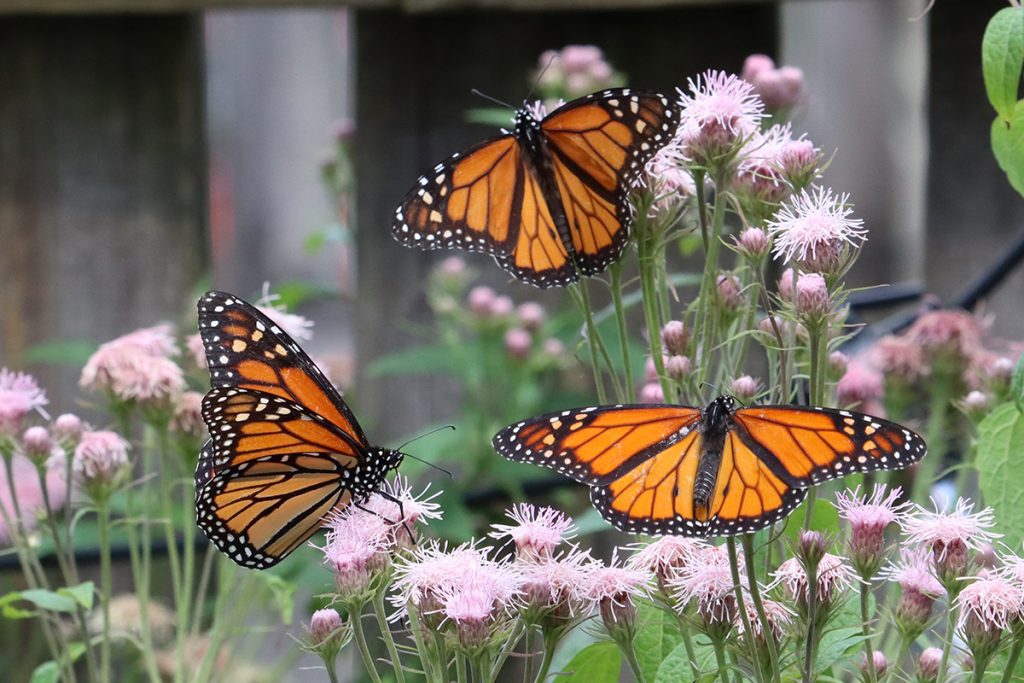
It blooms in the late summer, and is beloved by monarchs and polka dotted wasp moths. In fact, last summer I witnessed a lot of monarch breeding that was initiated right on these flowers- you can read about that on the Backyard Blog.
Spending a little extra time out there with a camera, I started noticing how much time bumblebees and sweat bees were also spending on the flowers. Those larger, showier insects had perhaps kept me from noticing that this is indeed a bee plant.
Another cool thing about Brickellia is that, while it is listed as Endangered in Florida, it grows easily in a garden. Those flowers turn into big puffy seedheads, and last year, I was able to grow a few new plants alongside their parents. It’s another one of these plants that gives you a few glorious weeks of pollinator action.
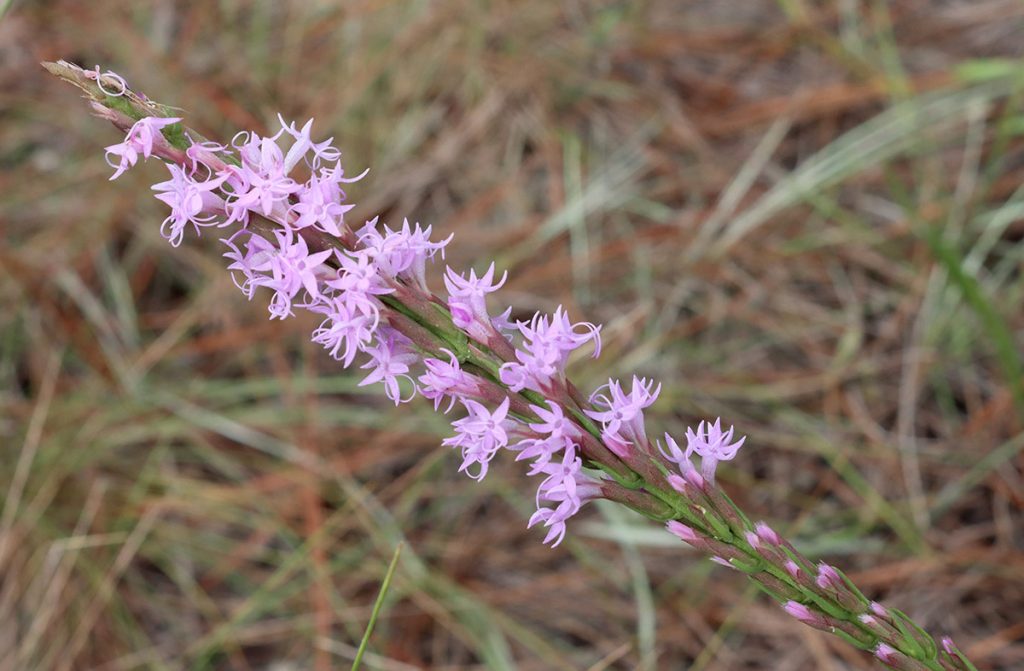
Blazingstars (Liatris sp.)
Blooms: August through October
Height: 3′- 4′
Full sun, dry sandy soils
Again, Lilly and I took our walk through the Munson Sandhills in mid-September. At that time, we could see blazingtars were just starting to bloom. Soon, these flowers would explode across these and other longleaf ecosystems across Florida.
“It’s another species that is a fire adapted species, because these habitats burn often.” Lilly said, waving her hand over a little tower of flowers. “And as you can see, it’s got clusters of flowers.”
A month later, I returned with my son Max for a little walk during the peak of wildflower season. The blazingstars were in full bloom, and were swarmed by a diversity of native bee species. You can see some photos below. I uploaded the cellophane bee photo to iNaturalist, where a bee researcher identified its species and left a comment that this was a rarely recorded, endemic bee species. According to Dr. John Ascher, it’s “historically overlooked due to late flight season.”
The long-faced cellophane bee flies late in the year, and tends to favor blazingstars, which bloom in the fall. This highlights the importance of including flowers for all seasons; different bees fly at different times of year.
“Just planting Liatris to attract bees is not going to support all of our bees that come out in early spring.” Lilly says. “For instance, they need the trees and shrubs, the flowering Ilex and Viburnum.”
According to the Florida Wildflower Foundation, there are four commercially available blazingstar species in Florida: Chapman’s blazingstar (Liatris chapmanii), graceful blazingstar (L. gracilis), dense blazingstar (L. spicata), and evergreen blazingstar (L. laevigata).
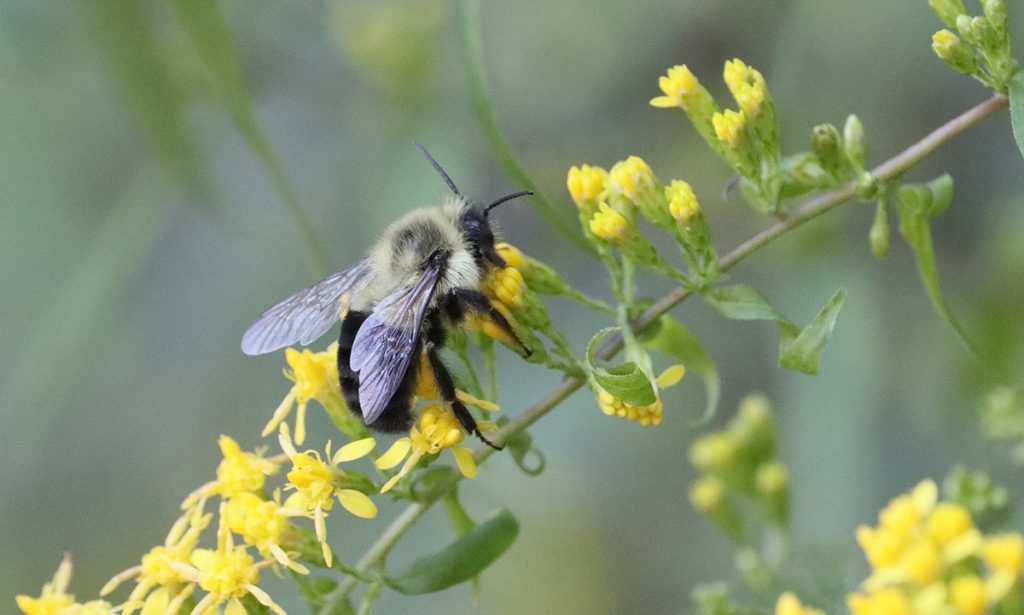
Goldenrods (Solidago sp.)
Blooms: August through November
Height: 1′- 6′
Sun/ part shade, dry or moist soils
It can’t be said enough- goldenrod does not trigger allergies. Ragweed blooms at the same time as goldenrod, and doesn’t need pollinators because it disperses its pollen into the air, and up your nose.
This is one of the last wildflowers to bloom in our area, and so it is of critical importance to late flying bees and other pollinators. I remember camping at St. Joseph Peninsula State Park on Veteran’s Day weekend, towards the end of the monarch migration season. Monarchs would feast on goldenrod behind sand dunes, building up energy before making the trek across the Gulf of Mexico to their wintering grounds.
A few species of goldenrod are available commercially, and it may also grow as a weed. According to the Florida Wildflower Foundation, Florida nurseries carry: seaside goldenrod (Solidago sempervirens), wand goldenrod (S. stricta), pinebarren goldenrod (S. fistulosa), and Chapman’s goldenrod (S. odora var. chapmmanii).
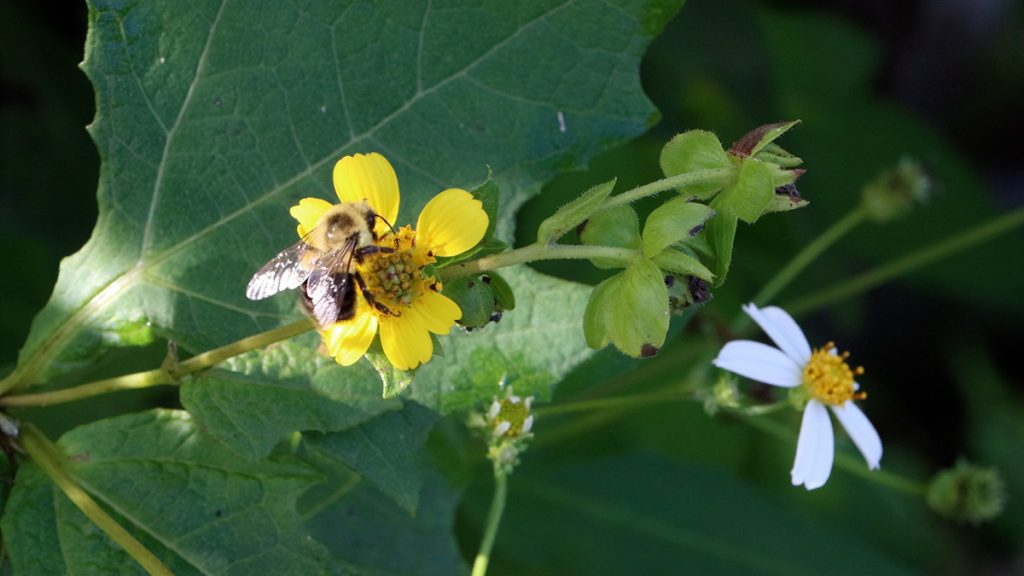
Bear’s Foot, aka Hairy Leafcup (Smallanthus uvedalius)
Blooms: June through October
Height: 2′- 10′
Sun/ part shade, dry or moist soils
As you can see in the photo above, the yellow bear’s foot flower has a similar small size and shape to its fellow Asteraceae, Bidens alba (slightly out of focus to the right of the bear’s foot). But check out those large leaves. Here’s a wildflower that gets kind of shrubby, with leaves that would provide cover for wildlife.
Bear’s foot can grow as a weed; consider keeping it if you have space for a plant with a larger footprint.
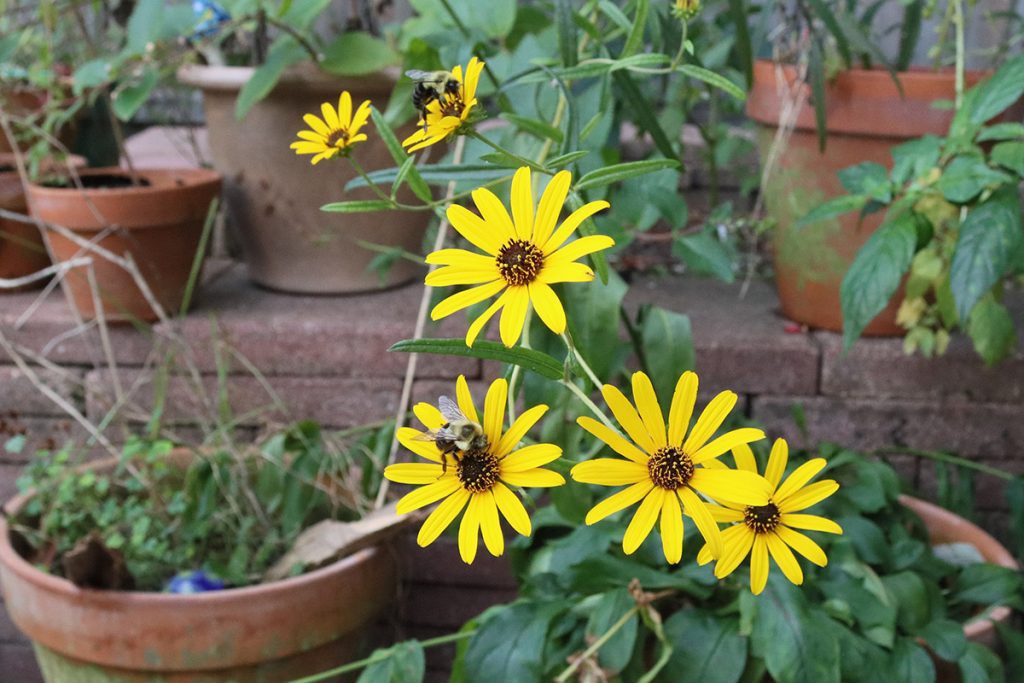
Narrowleaf Sunflower, aka Swamp Sunflower (Helianthus angustifolius)
Blooms: October
Height: 1′- 3′
Part shade, wet soils
I’ll highlight a few sunflower species now. Giant sunflower is the species many of us will think of in a garden- it’s the iconic shape we associate with sunflowers. Its native range is just north of Florida. We do, however, have several species native to our state that grow in a variety of conditions.
Take the swamp sunflower. It’s a sunflower that grows in wet, partially shady places, though it has done well with the drier conditions in my yard.
You’ll notice how many fall blooming flowers are on this list. Consider that pollinators here evolved on a landscape where fall is the peak wildflower season. Our homes replaced a part of that habitat, but we can support pollinators by mimicking it. Last year, I decided that I needed more late season flowers, and was happy to see bees and butterflies make use of them.
I started all of our swamp sunflowers from seeds given to me by a friend. They grew easily from seed. In 2021, the flowers persisted into early November before dying back; almost immediately, the plants sprouted basal leaves to start next year’s growth.
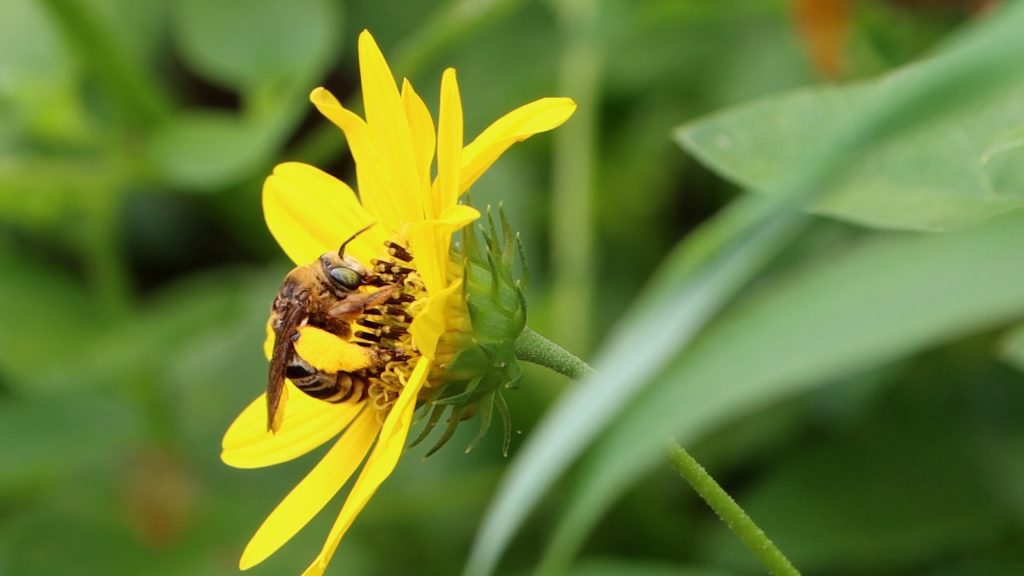
Dune Sunflower (Helianthus debilis)
Blooms: January through December
Height: 1′- 3′
Full sun, sandy soils
Here is a plant both Mark and Elizabeth recommend. It’s native to Florida’s coasts, but does well inland as well. A lot of the sandy soils in our area had once been beach dunes or ocean bottom, so there are plants that thrive in both locales.
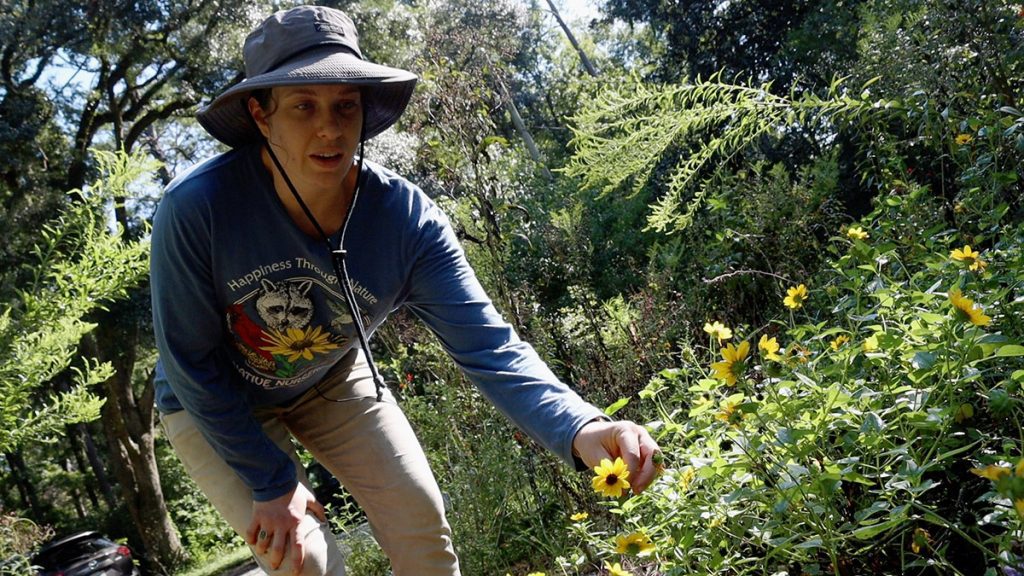
As you can see in the photo above, beach dune sunflower can spread and cover some ground. It can bloom almost all year long if it’s a warm winter. “Really easy to grow,” Marks says, “doesn’t need much water, doesn’t really need much fertilization at all. Just a good, kind of rich soil.”
Rayless Sunflower (Helianthus radula)
Blooms: September through November
Height: 1′- 3′
Full sun, well drained moist soils
Here’s another late blooming flower with a different kind of look.
“This species, it doesn’t look like a sunflower because it doesn’t have the ray petals that we think of as being a key feature,” Lilly says. “but it has all of what we call disc flowers, which are all those little center flowers that are just as valuable as the ray flowers.”
For most of the year, rayless sunflowers lie low. You can see its basal leaves in the photo above. Before their stalks shoot up, you can mow right over the leaves. Compare with elephant’s ear, which you can see below. Both persist as large basal leaves for much of the year, and bloom around the same time.
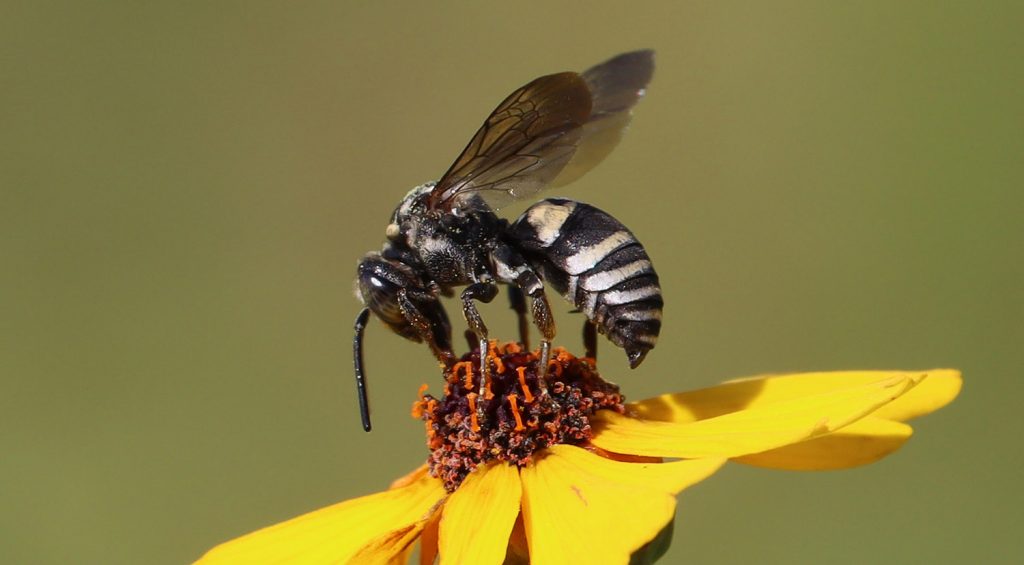
Tickseeds (Coreopsis genus)
Almost a full year after writing this piece, I’m adding the flowers that hosted more bees than any other over the spring and most of the summer of 2022. Of the tickseed species native to Florida, I have lance-leaved Coreopsis and Leavenworth’s Coreopsis.
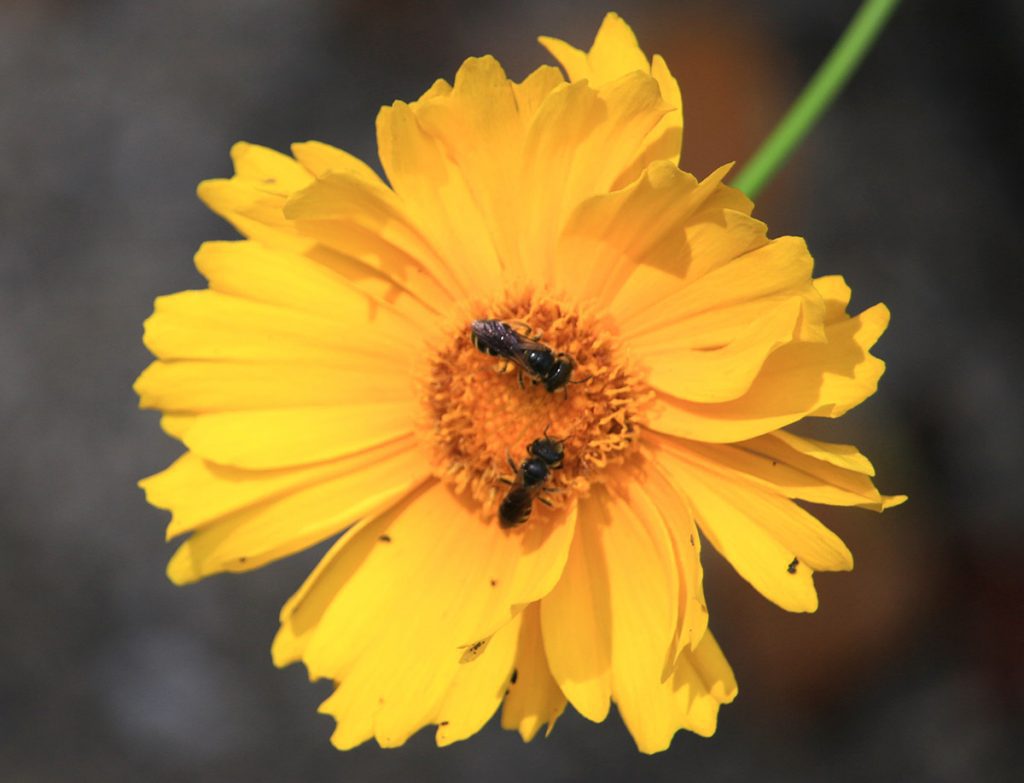
Both start easily from seed. I started our lance-leaved Coreopsis from seeds passed out by the Florida Native Plant Society a few years back. Ever since, it has spread on its own; and if I don’t like where a new plant pops up, I transplant it.
I find the Leavenworth’s Coreopsis blooms much more prolifically and consistently. I bought one plant three years ago, which turned into four in 2021 and around 20 in 2022. We’ll see how many pop up in 2023.
Groundcover Plants
None of our bee partners talked about groundcover plants, but I’m including them for a couple of reasons. One is that I’ve seen quite a few bees on sensitive plants, including some less common ones at Elinor Klapp-Phipps Park (pictured above). Another is that you can use native groundcover plants instead of grass where you don’t have heavy foot traffic, and because they spread out above ground, there’s a lot of space beneath them for bees to nest compared with turfgrass.
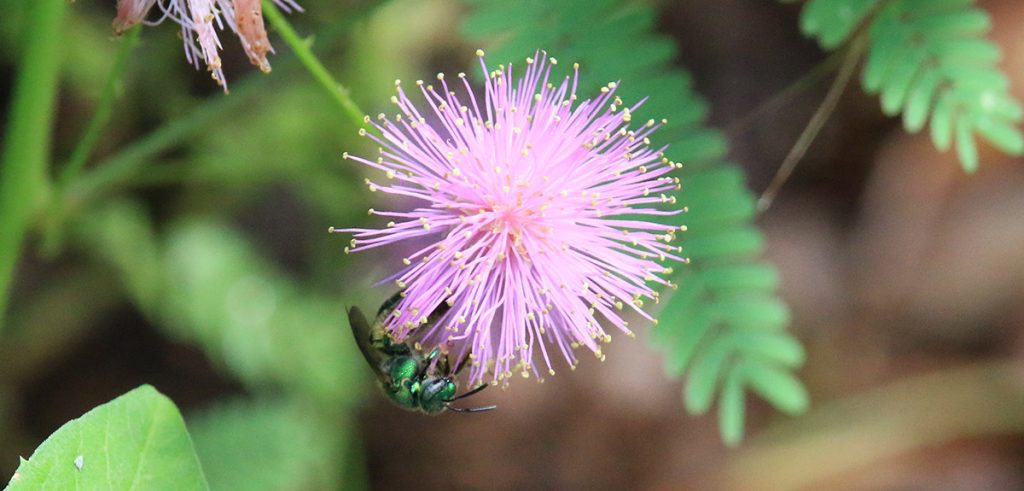
Sunshine Mimosa (Mimosa strigillosa)
Blooms: March through October
Sun/ part shade, dry or moist soils
I have sunshine mimosa in my yard, but you can also find littleleaf sensitive-briar and fourvalve mimosa in Leon County. Sensitive plants are in the pea family (Fabaceae), so they are nitrogen fixers. I’ve noticed sweat bees and bumblebees on the pink puffball flowers in our yard, and leafcutter, mason, and sweat bees at Klapp-Phipps.
If you have a little space, this will spread.
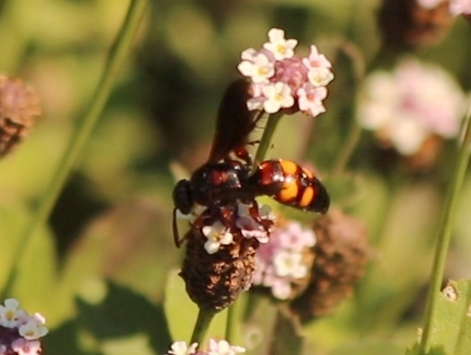
Turkey Tangle Frogfruit (Phyla nodiflora)
Blooms: May through October
Sun/ part shade, dry or moist soils
I would recommend fogfruit it for the name alone (yes, it’s called both fogfruit and frogfruit). It’s a larval food for common buckeye butterflies, and bees and wasps visit the flowers.
“Weeds”
A couple of these are in the aster family, but I include them here because they want to grow for free in your yard. I wrote about weeds early last year. If you let any space go unchecked in your yard, you’ll get a mix of natives and nonnatives, and even aggressively invasive plants. I wrote about identifying and learning about your weeds, to help you decide whether they’d work in your yard. The ones I’ve listed here are particularly bee-friendly.
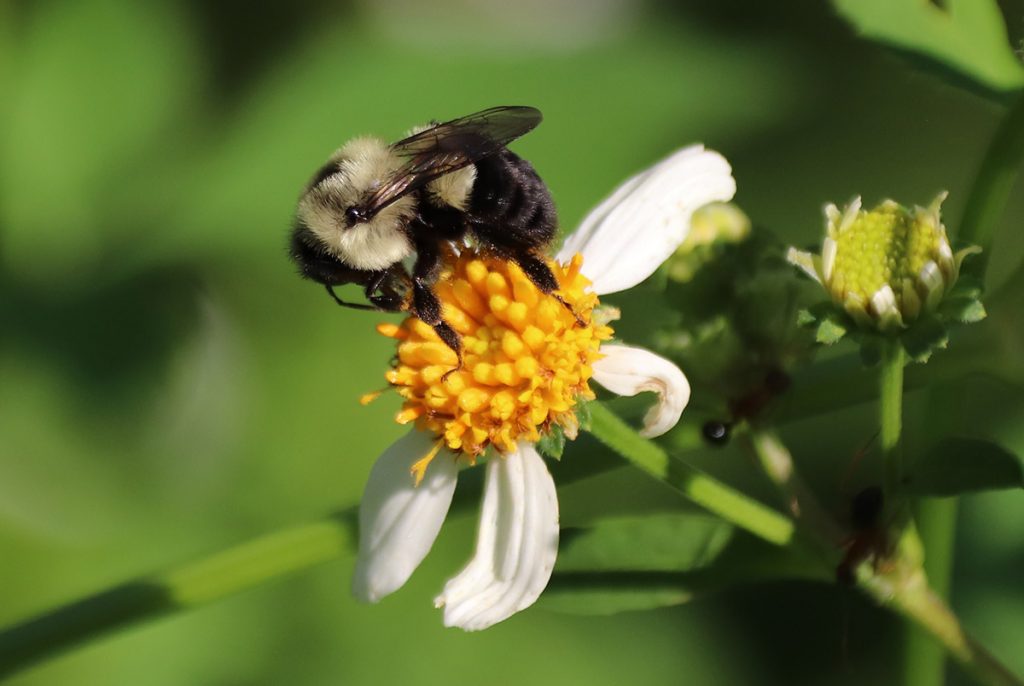
Spanish Needles (Bidens Alba)
Blooms: January through December
Height: 1′- 4′
Sun/ part shade, dry or moist soils
“If you have a spot in your yard that you let go wild,” says Mark Tancig, “you are going to get Spanish needles, or Bidens alba… It’s very weedy. It’s annoying because it gets stuck to your clothes. But this thing is great.”
The “needles” are its seeds, which will stick to your clothes even if you’re looking at the plant from across the street inside your car (not really). They also grow pretty much anywhere, which you may or may not love. To me, it means I can pick and choose where these composite, beloved-by-pollinator flowers grow in my yard. If you’re Jonathan Lammers, you may, as in the “Weeds” banner image above, allow a Bidens alba meadow to flourish in your yard.
The reason that every bee partner mentioned this plant, aside from the fact that bees and butterflies love it, is that it blooms year-round. This last December was warm enough that, on two occasions, I saw bumblebees flying. They typically overwinter in leaves or underground in December, but it was a warm one. Both times I saw them, they were on the most widely available flower at the time: Bidens alba.
If you have the space, it’s a high value plant that grows without your having to give it any thought.
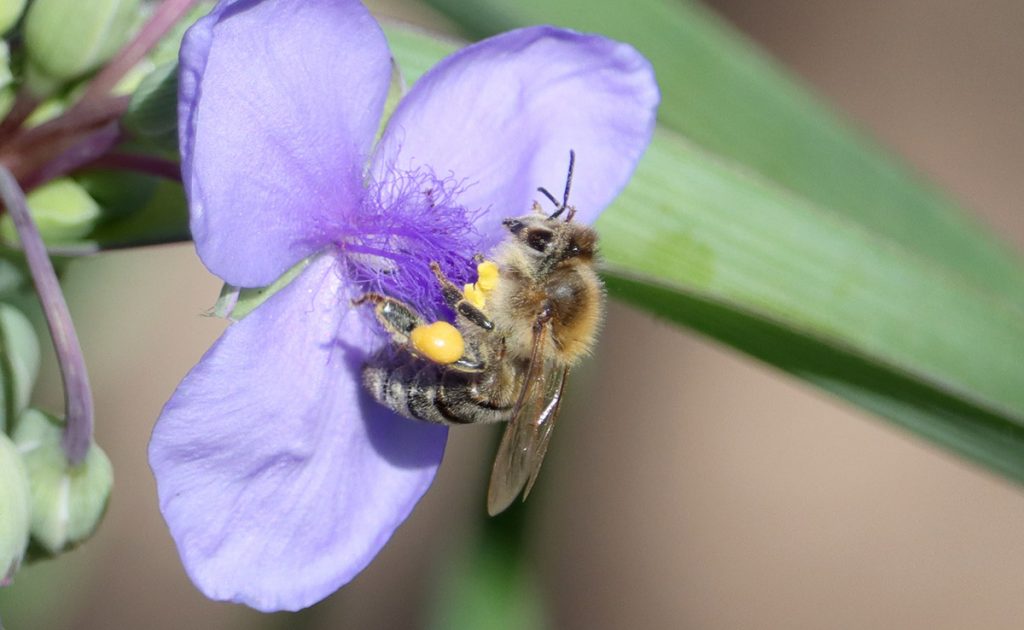
Ohio Spiderwort (Tradescantia ohiensis)
Blooms: Almost all year round
Height: 1′- 3′
Part shade, dry or moist soils
Here’s another one you’ll see if you stop mowing all or part of your yard, and which pretty much blooms all year. By late March/ early April, the cherry laurel blooms fade, and most of the wildflowers I planted haven’t yet flowered. At this time, I see honeybees, carpenter bees, bumblebees, and the tiny Dialictus sweat bees all over Ohio spiderwort.
This is a plant you can let grow for parts of the year (I like a shaggy yard in winter and early spring), mow down, and it’ll grow back when you let it get shaggy again.
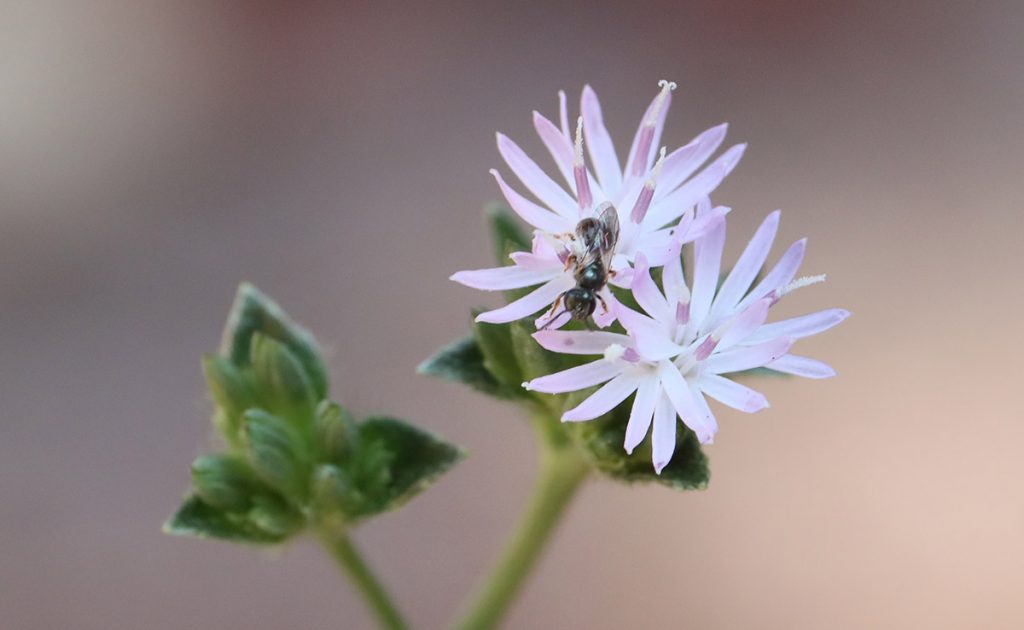
Elephant’s Foot (Elephantopus sp.)
Blooms: August through November
Height: 1′- 2′
Like the rayless sunflower, elephant’s foot spends most of the year as large basal leaves. They may grow as weeds in your yard, lying flat under your mower as they wait for late summer. At that point, they’ll shoot up and produce a little aster flower, a good size for small bees.
Congratulations on making it to the bottom of the post.
You may be wondering why we left certain flowers off the list. I think we’ve collected fundamental species of every size and seasonality, and our partners have shared important concepts about the types of plants you can include. There are so many others that would compliment these in the garden, and which I may add in later- salt and pepper plant, tickseeds (Coreopsis), or fall asters (Symphyotrichum), for instance.
I also don’t want to make you all feel bad if you don’t totally transform your yard after reading this. Not every yard has a ton of space for trees and shrubs, and not everyone has the money to buy a ton of plants. I’ve built our garden over years, incrementally, while learning what “weeds” would enhance it. Even if you place a couple of potted native wildflowers on a balcony, you’re doing something.
For any of you who are just starting your bee friendly garden, I say good luck. And bee patient. It can take a little experimentation and observation to turn your garden into a of habitat full of bees and butterflies, but the payoff is well worth it.
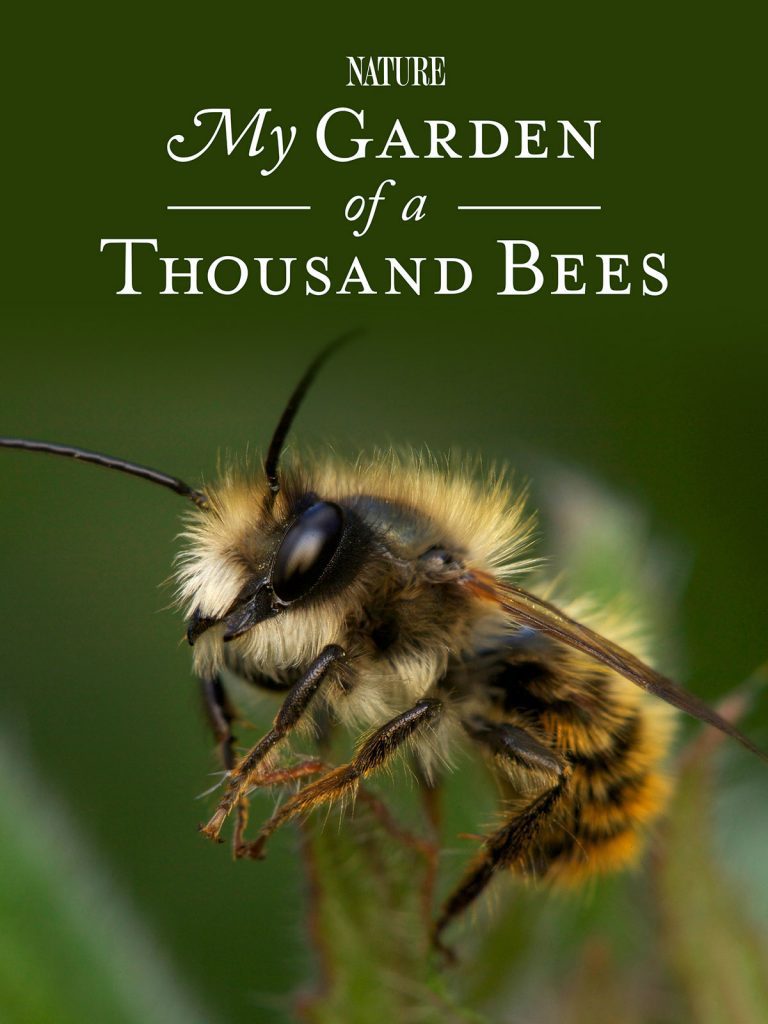
This video was produced with a grant from PBS | Nature
NOW STREAMING- PBS Nature: My Garden of a Thousand Bees. The story focuses on wildlife filmmaker Martin Dohrn. With the world on lockdown in 2020, Dohrn turned his camera on the small garden in his backyard, discovering the diverse world of wild bees.
Through a grant from PBS Nature, WFSU hopes to create a similar experience for our viewers in the north Florida/ south Georgia area. Any outdoor space has potential to attract bees. Our partners at Native Nurseries of Tallahassee, the UF/ IFAS Leon County Extension, and Florida Native Plant Society are sharing their considerable knowledge with us. We hope you’ll join us and create a bee friendly habitat in your own yard. On this page is the information you need to get started.
Support for Nature: My Garden of a Thousand Bees was provided by The Hite Foundation, Bradley L. Goldberg Family Foundation and The Sun Hill Family Foundation in memory of Susan and Edwin Malloy. Series funding for Nature is also made possible in part by the Arnhold Family in memory of Henry and Clarisse Arnhold, The Fairweather Foundation, Kate W. Cassidy Foundation, Sue and Edgar Wachenheim III, Kathy Chiao and Ken Hao, Charles Rosenblum, Filomen M. D’Agostino Foundation, Lillian Goldman Charitable Trust, Leonard and Norma Klorfine, Sandra Atlas Bass, Colin S. Edwards, Gregg Peters Monsees Foundation, Koo and Patricia Yuen, by the Corporation for Public Broadcasting and by public television viewers.
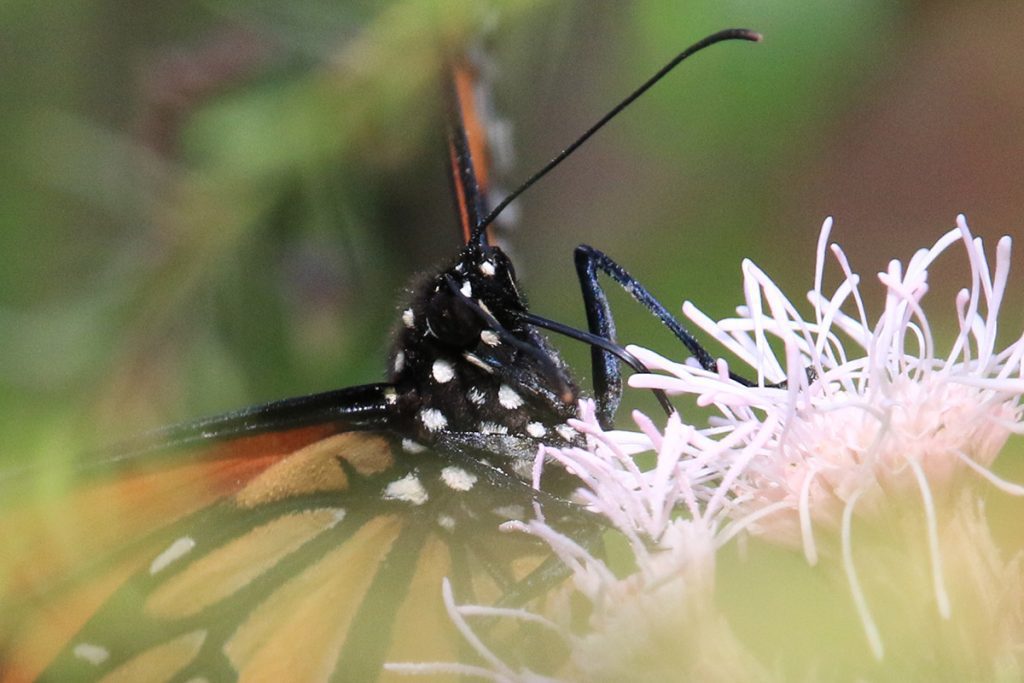
Dig Deeper into Backyard Ecology
What can we do to invite butterflies, birds, and other wildlife into our yards? And what about the flora and fauna that makes its way into our yards; the weeds, insects, and other critters that create the home ecosystem? WFSU Ecology Blog takes a closer look.
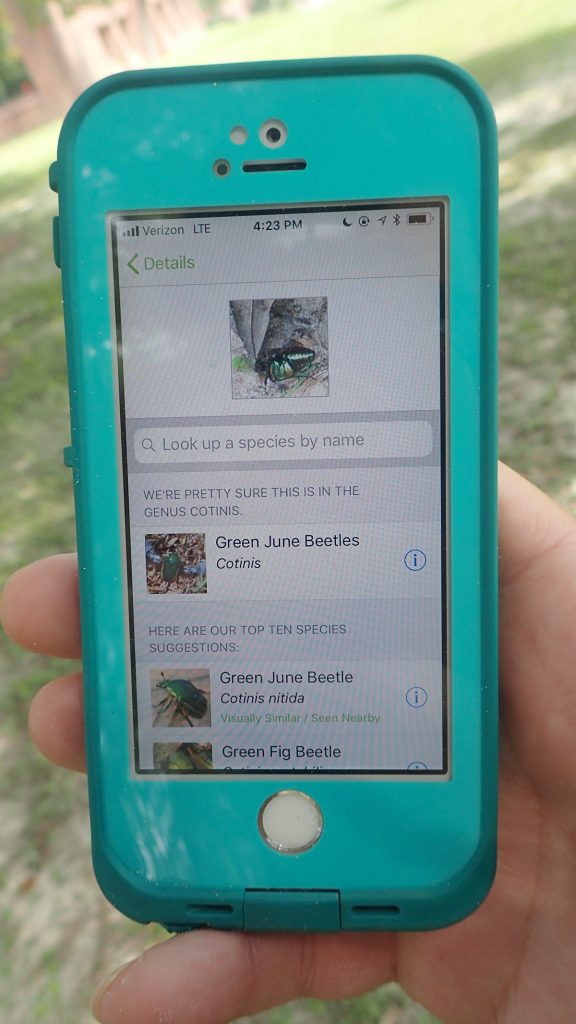
Apps and Citizen Science mentioned in the Backyard Blog
iNaturalist
Identify plants, animals, lichens, and fungi in your yard. Other users correct your identifications if you’re wrong, and even if they don’t, it can be a good springboard to further research.
Seek by iNaturalist
Instant identification, and it doesn’t record your location. This is a good option for kids with phones.
Monarch Larva Monitoring Project
Enter information about monarch caterpillars in your yard, and help researchers get a sense of the health of the monarch population that year, and how and when they’re migrating.
Great Sunflower Project
Record the number of pollinators visiting your flowers, and help researchers map pollinator activity across the country.

